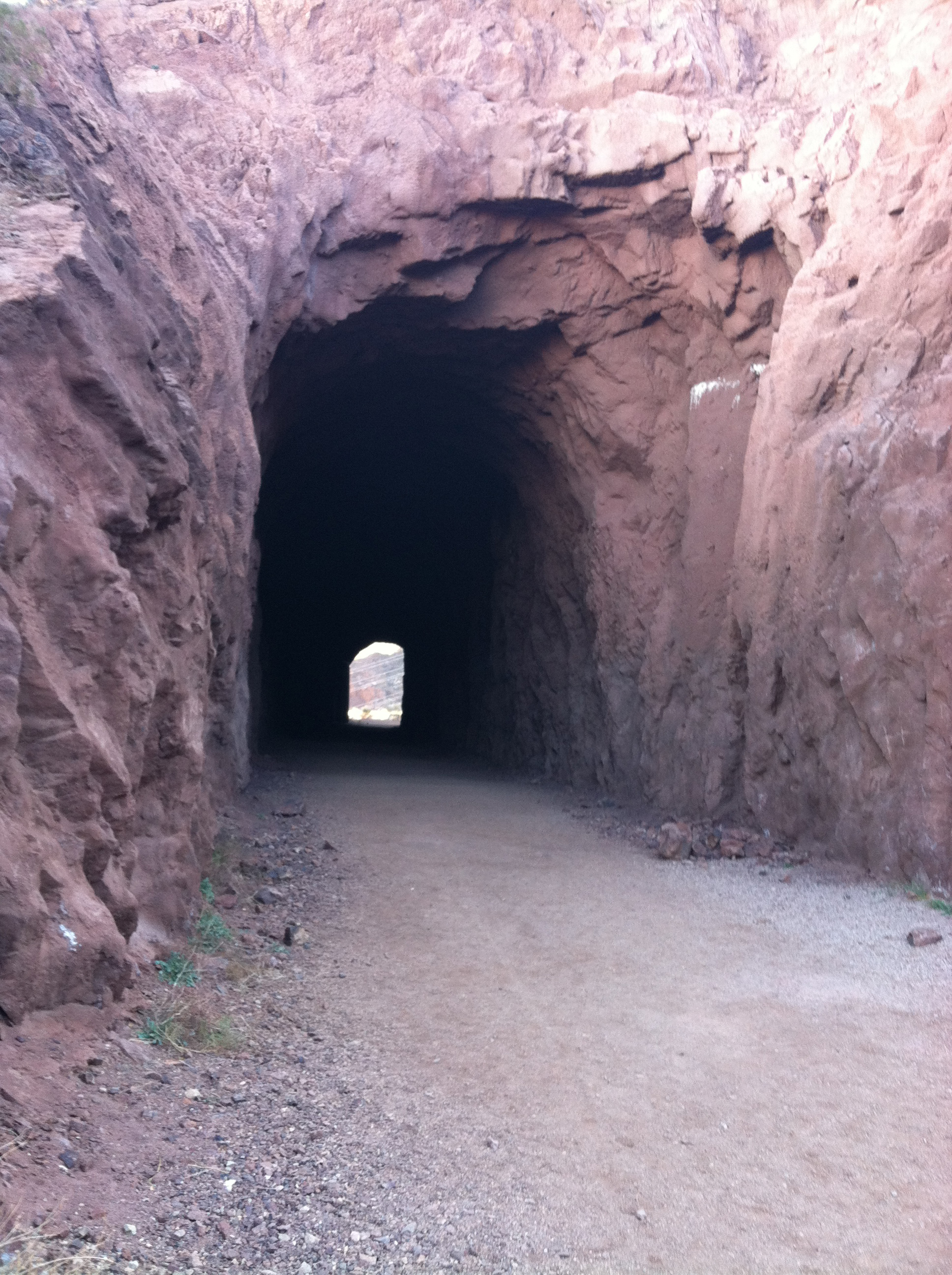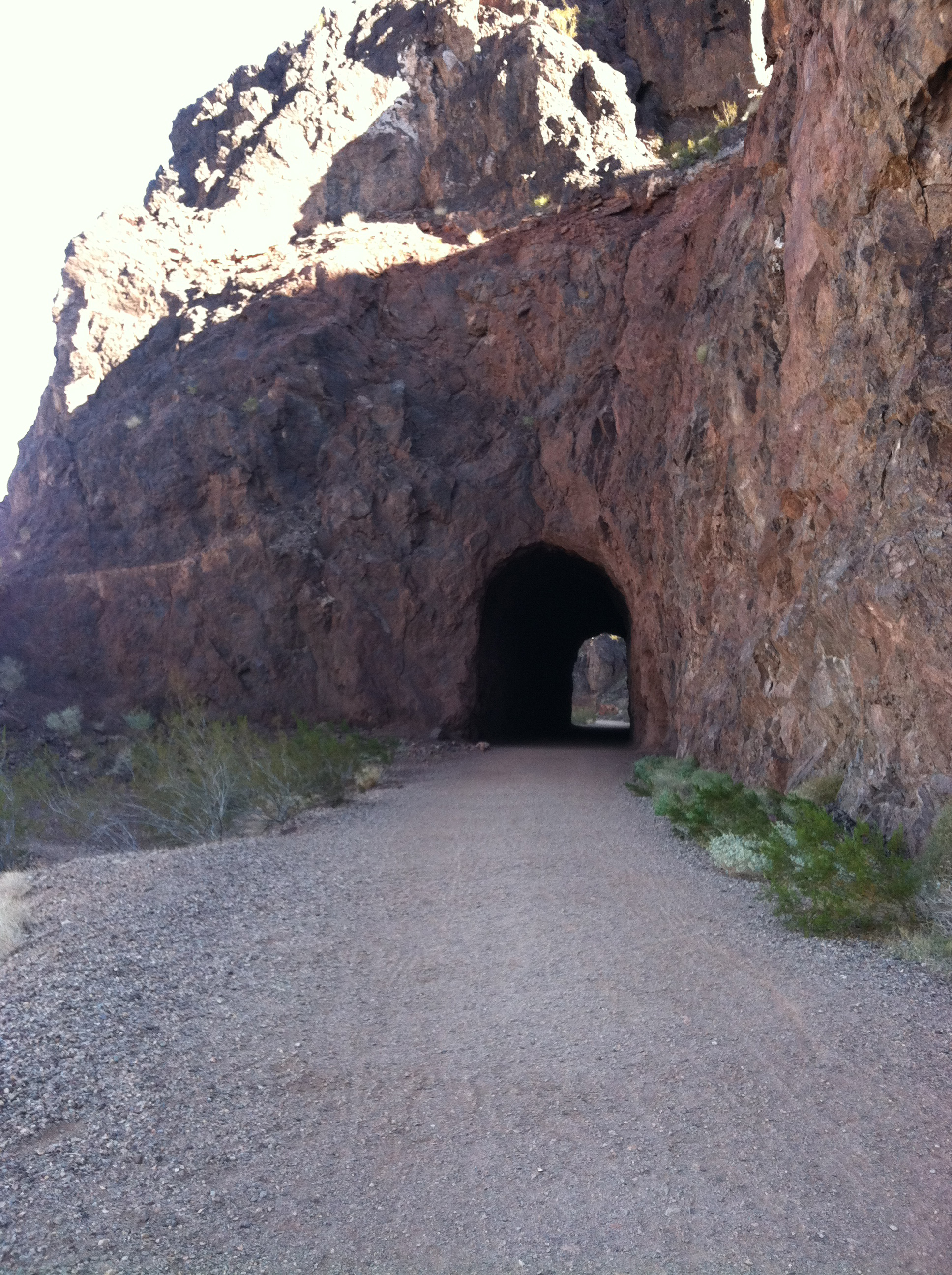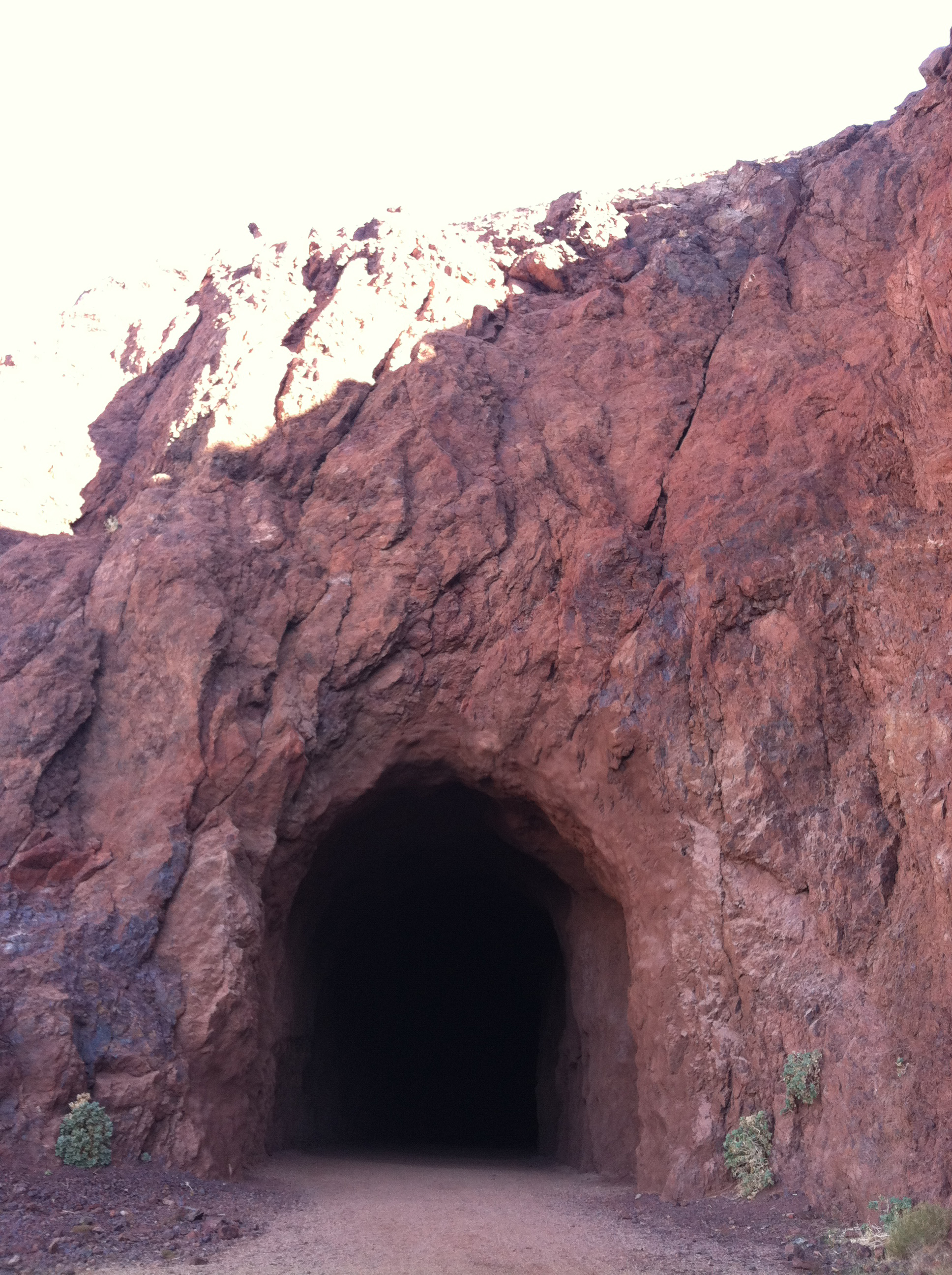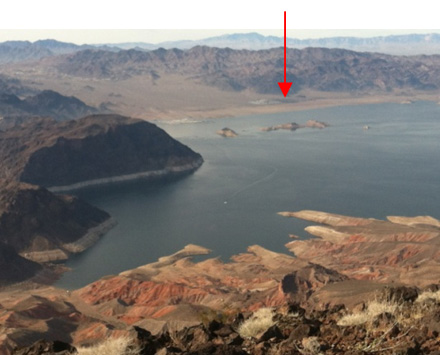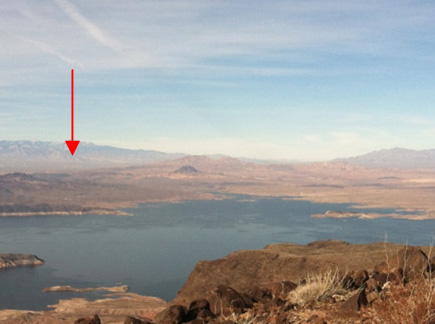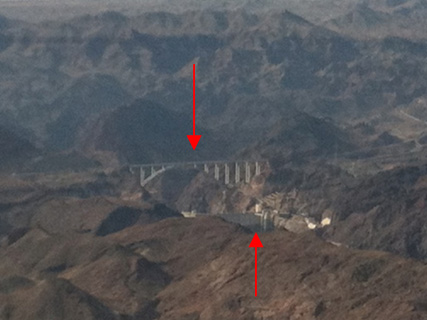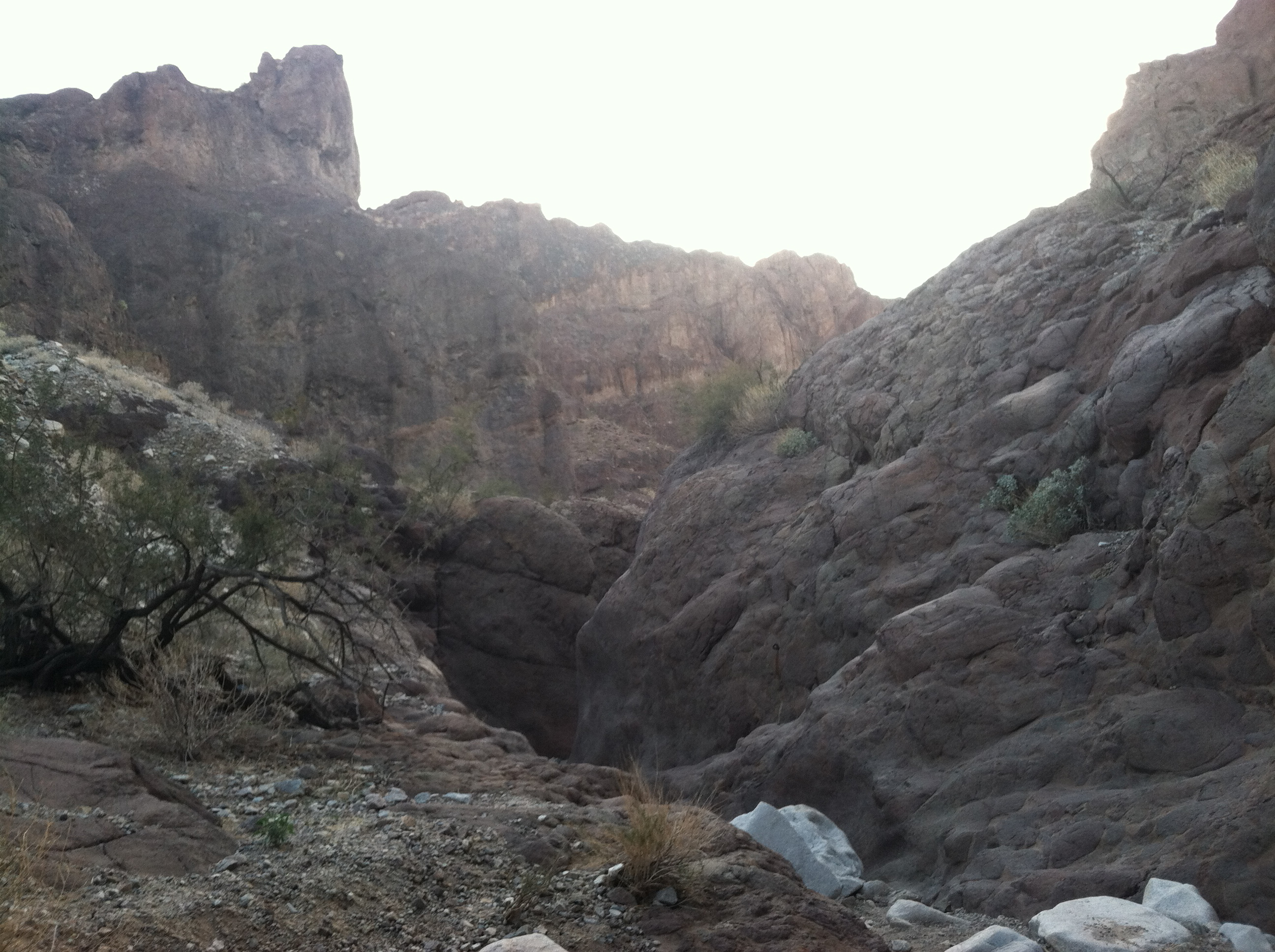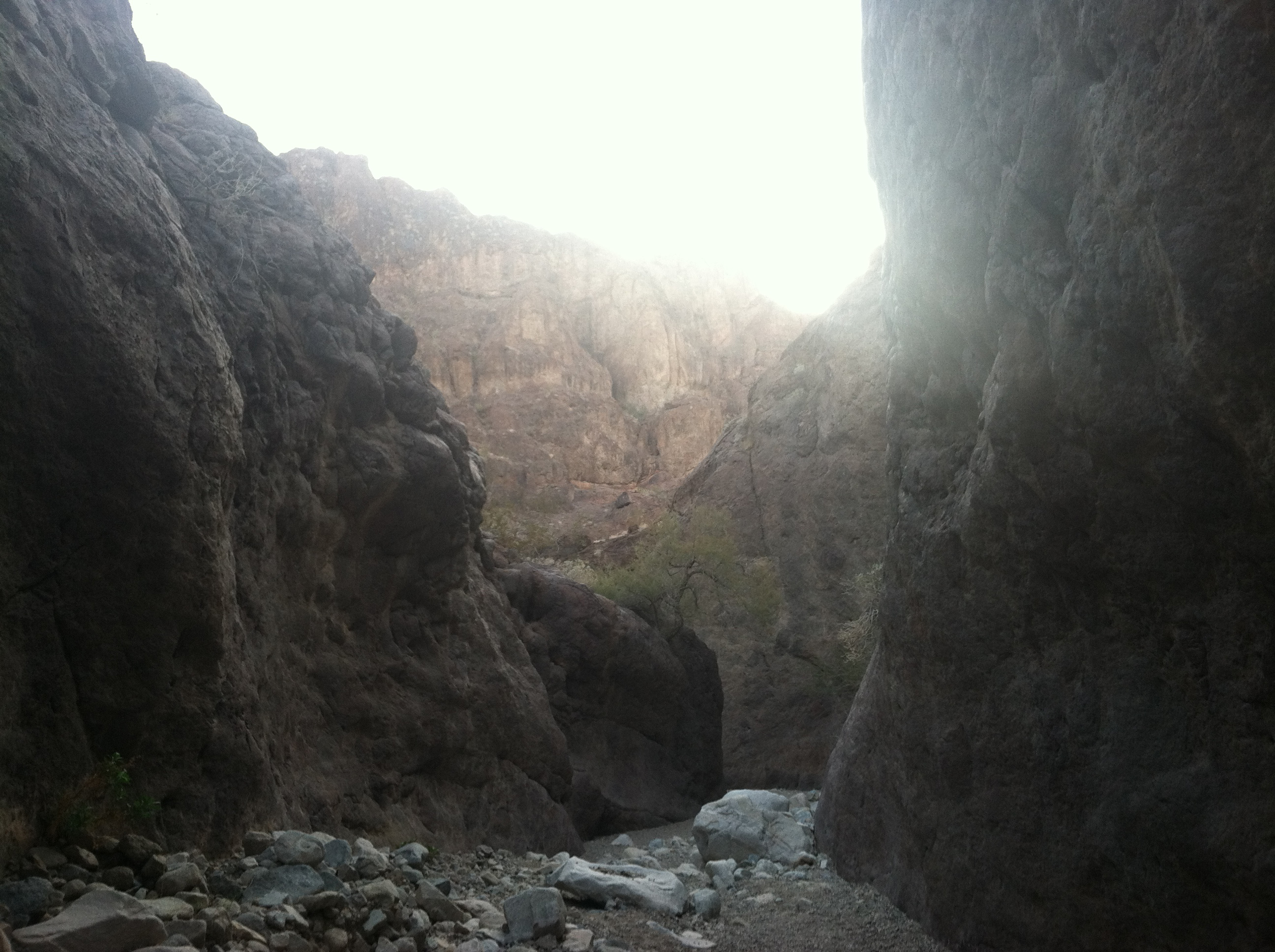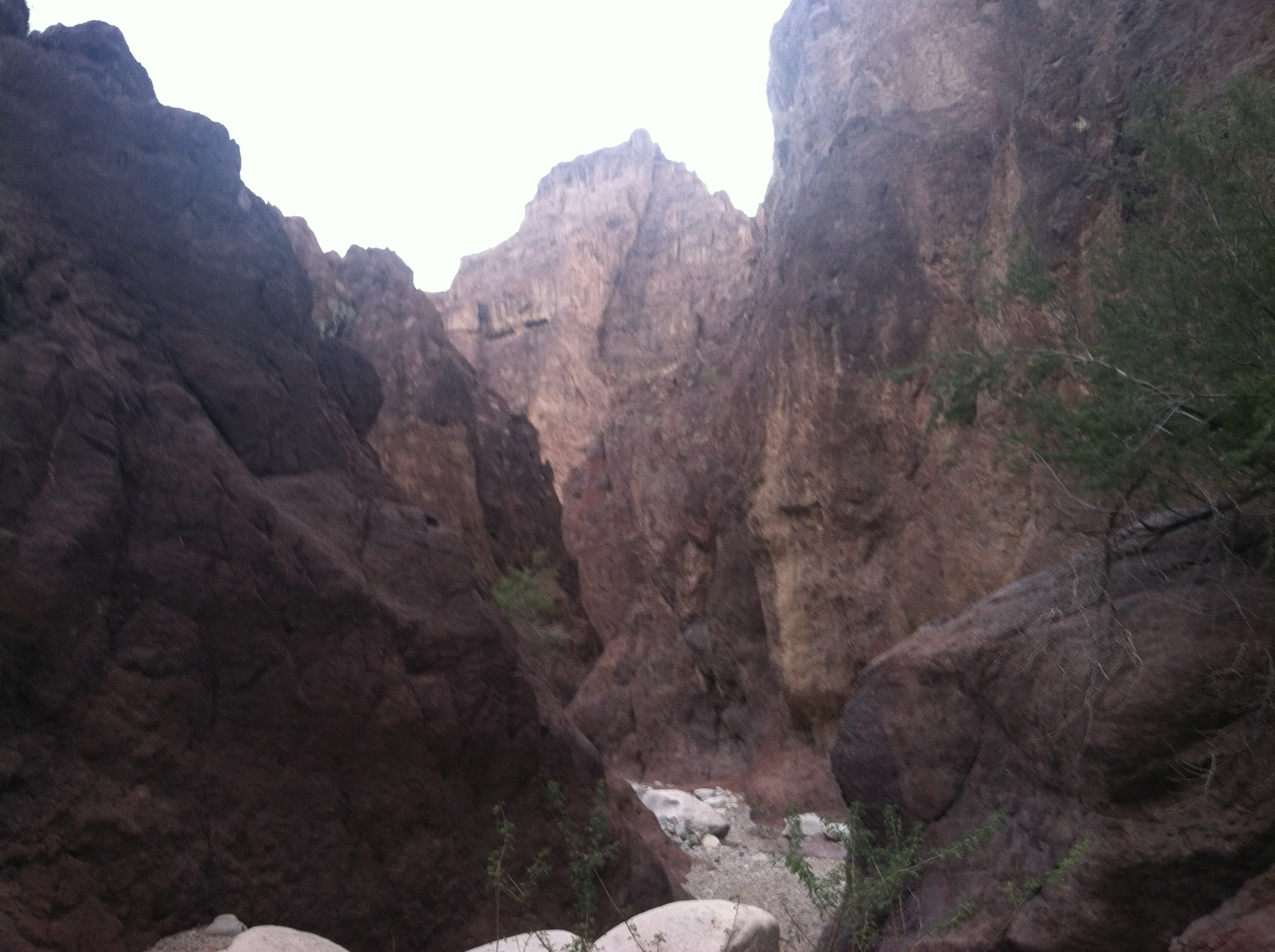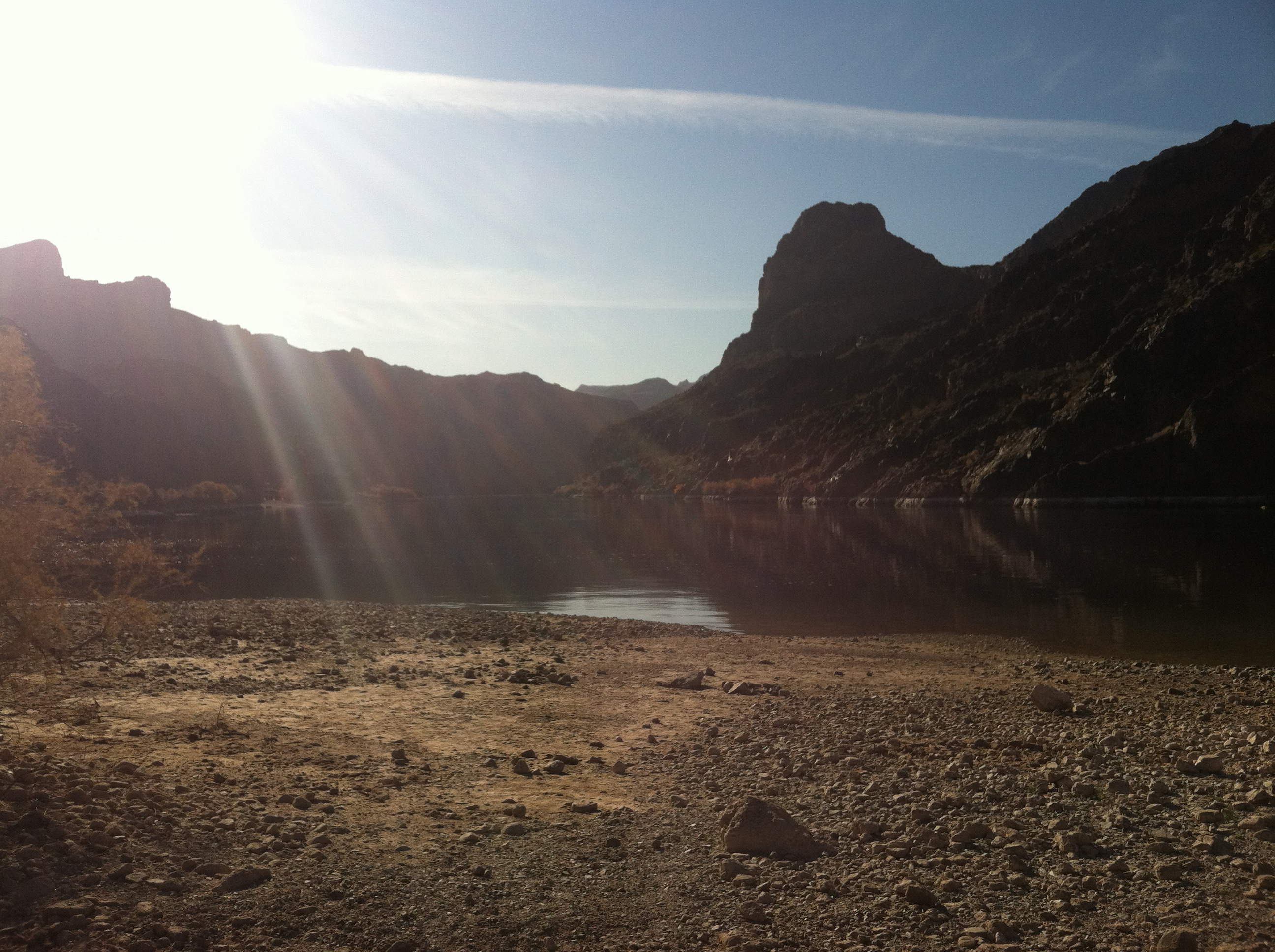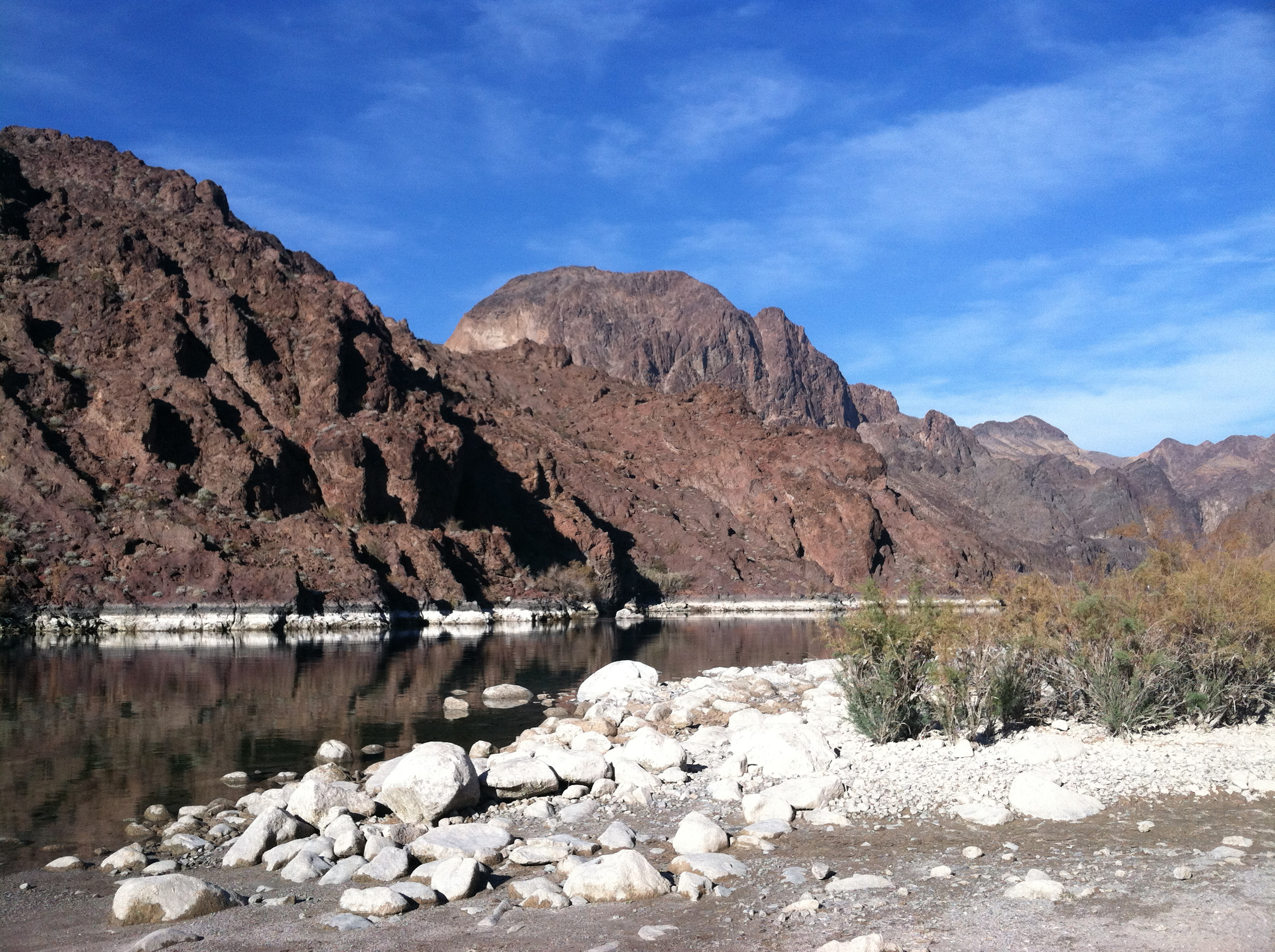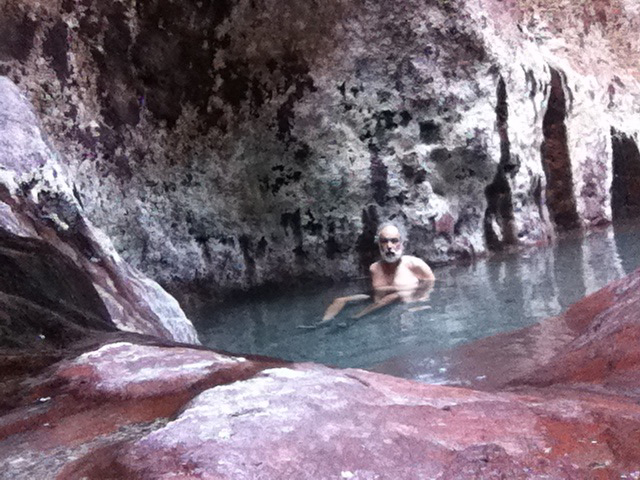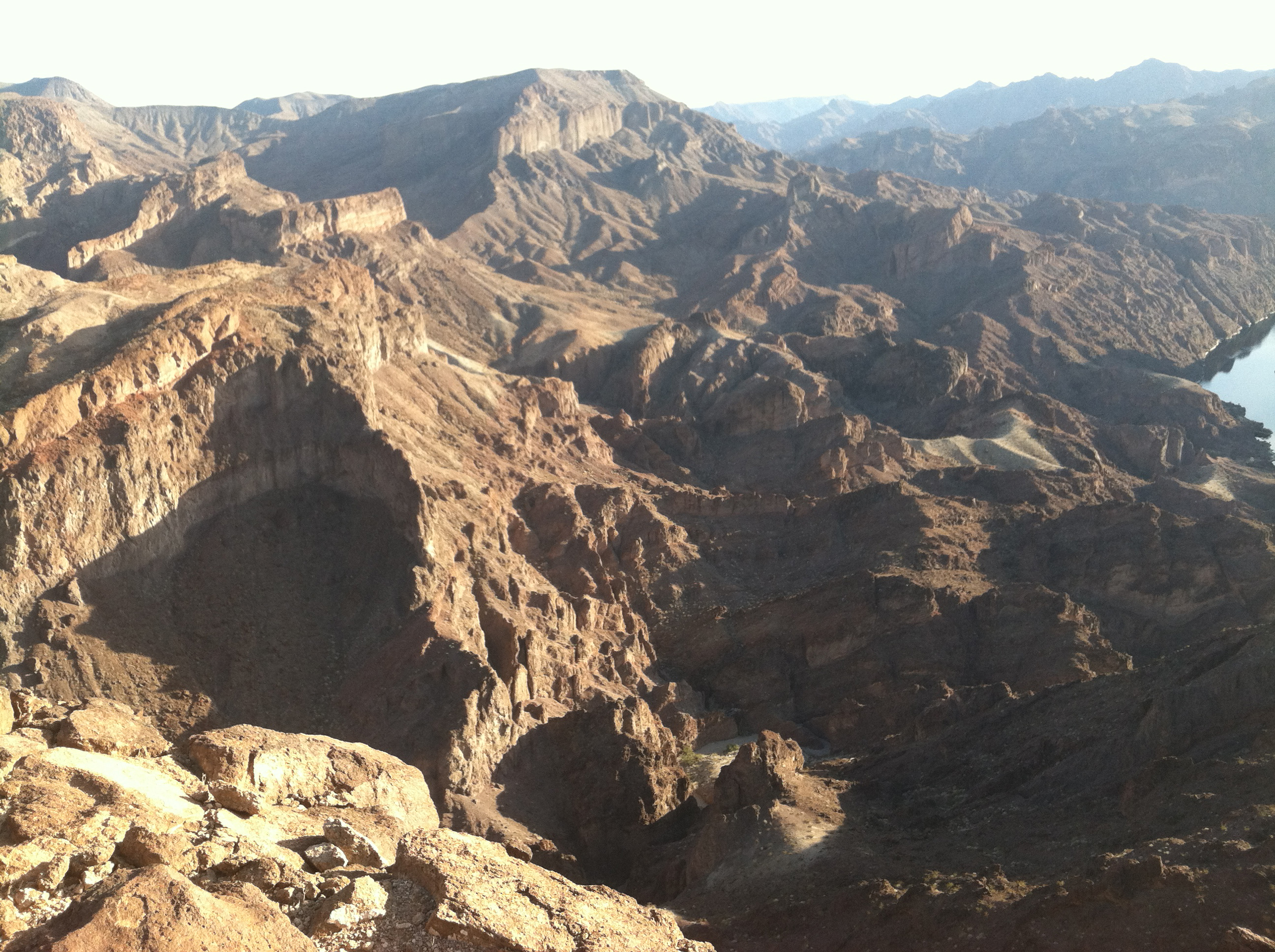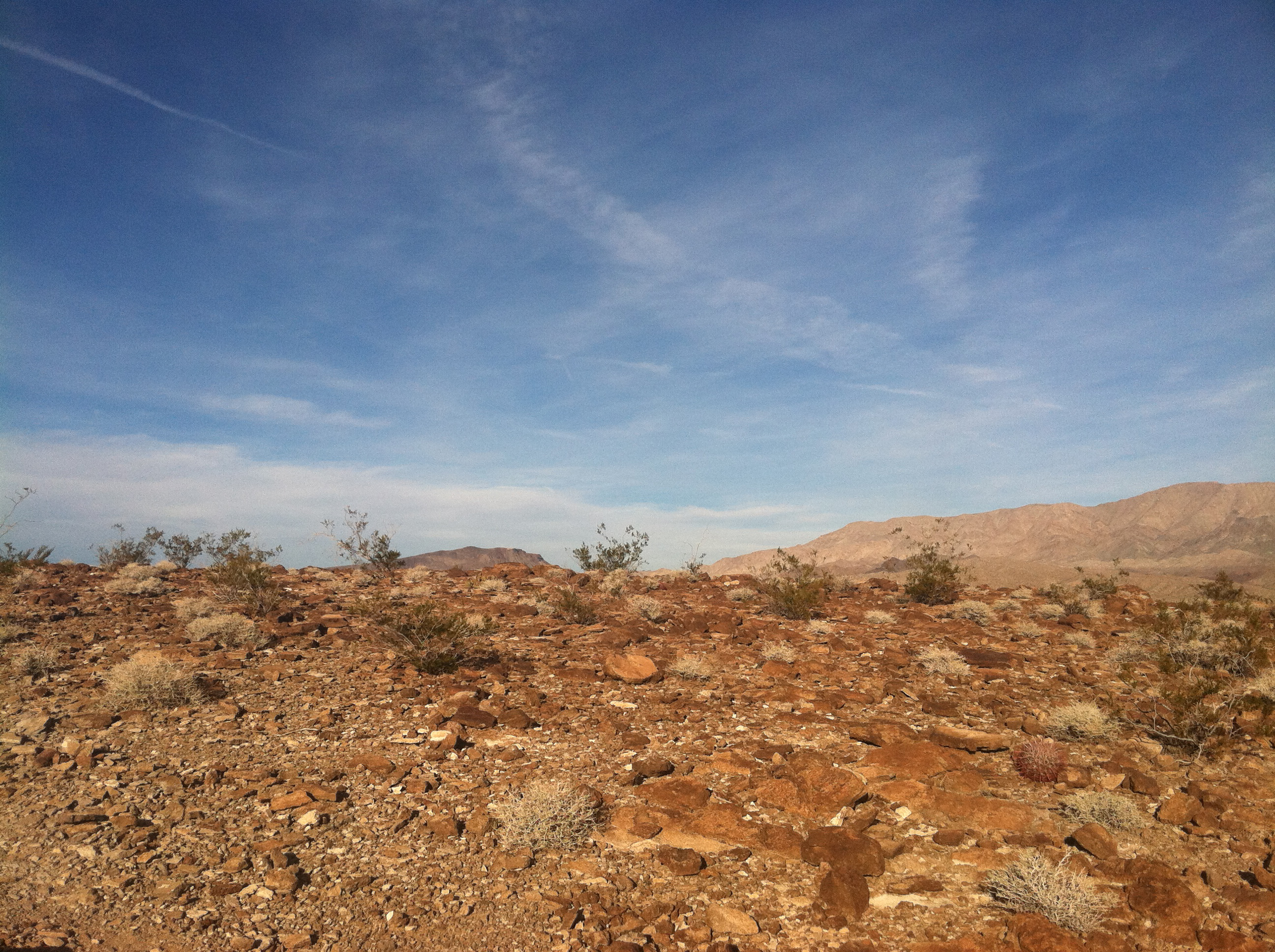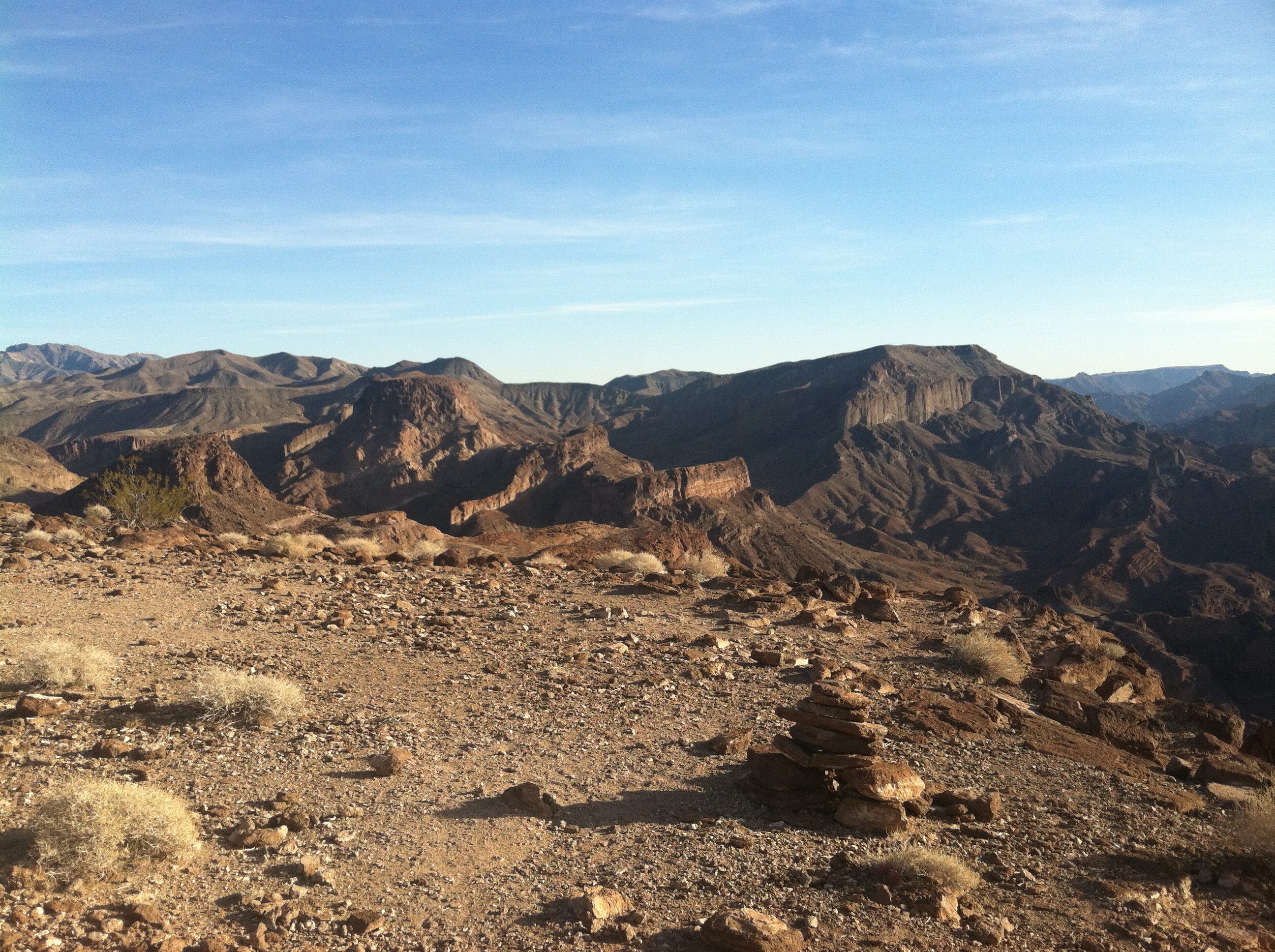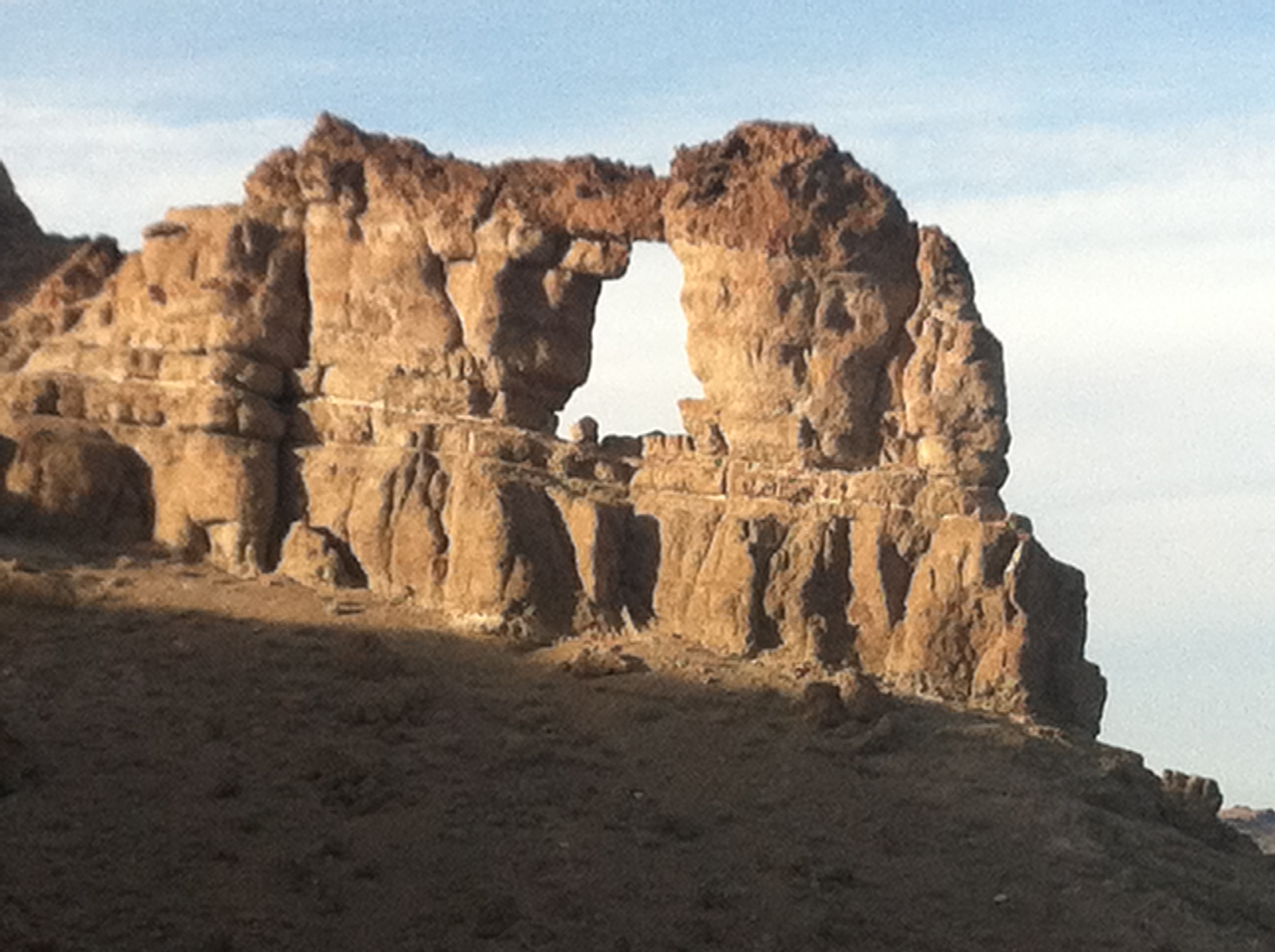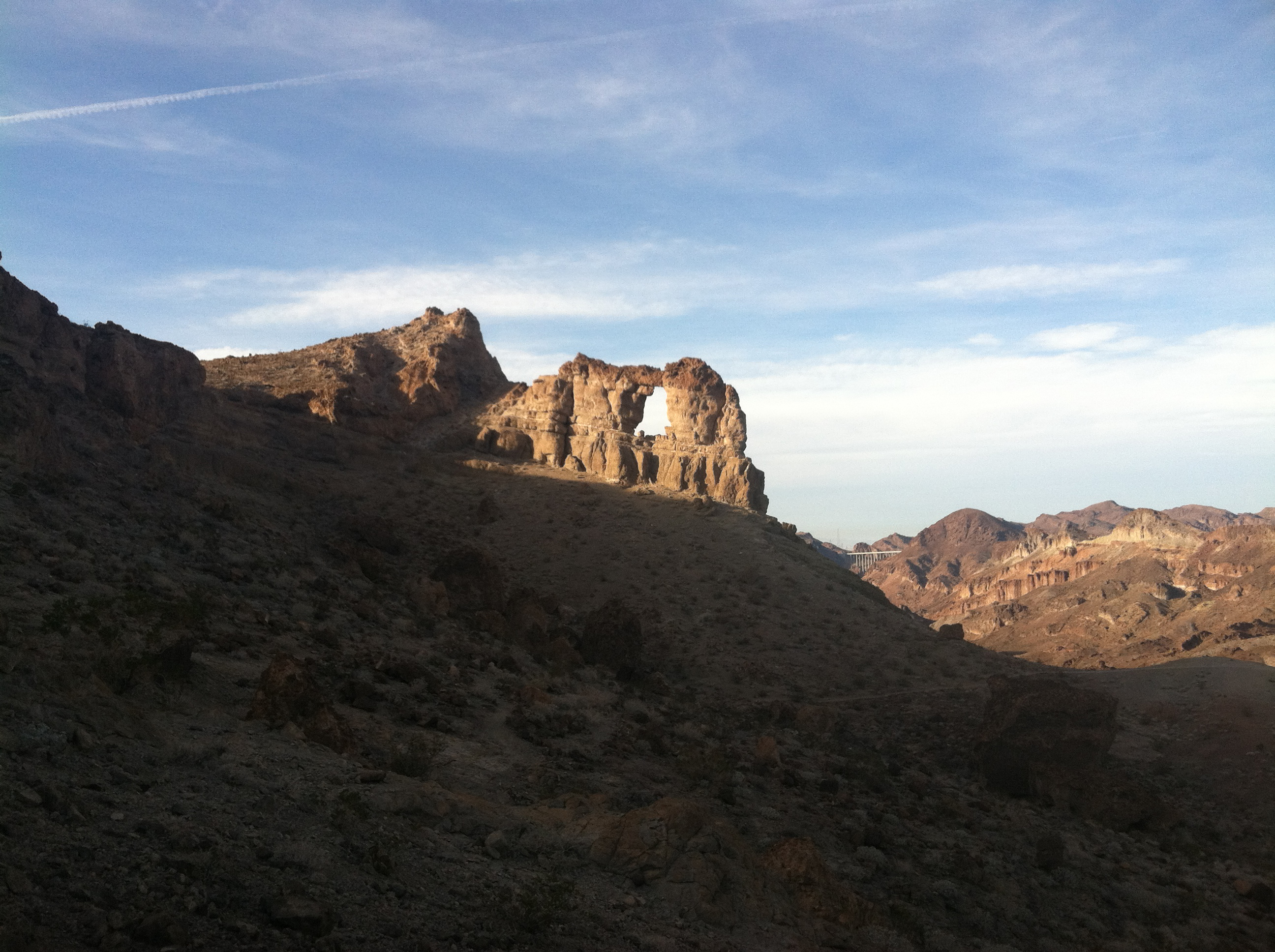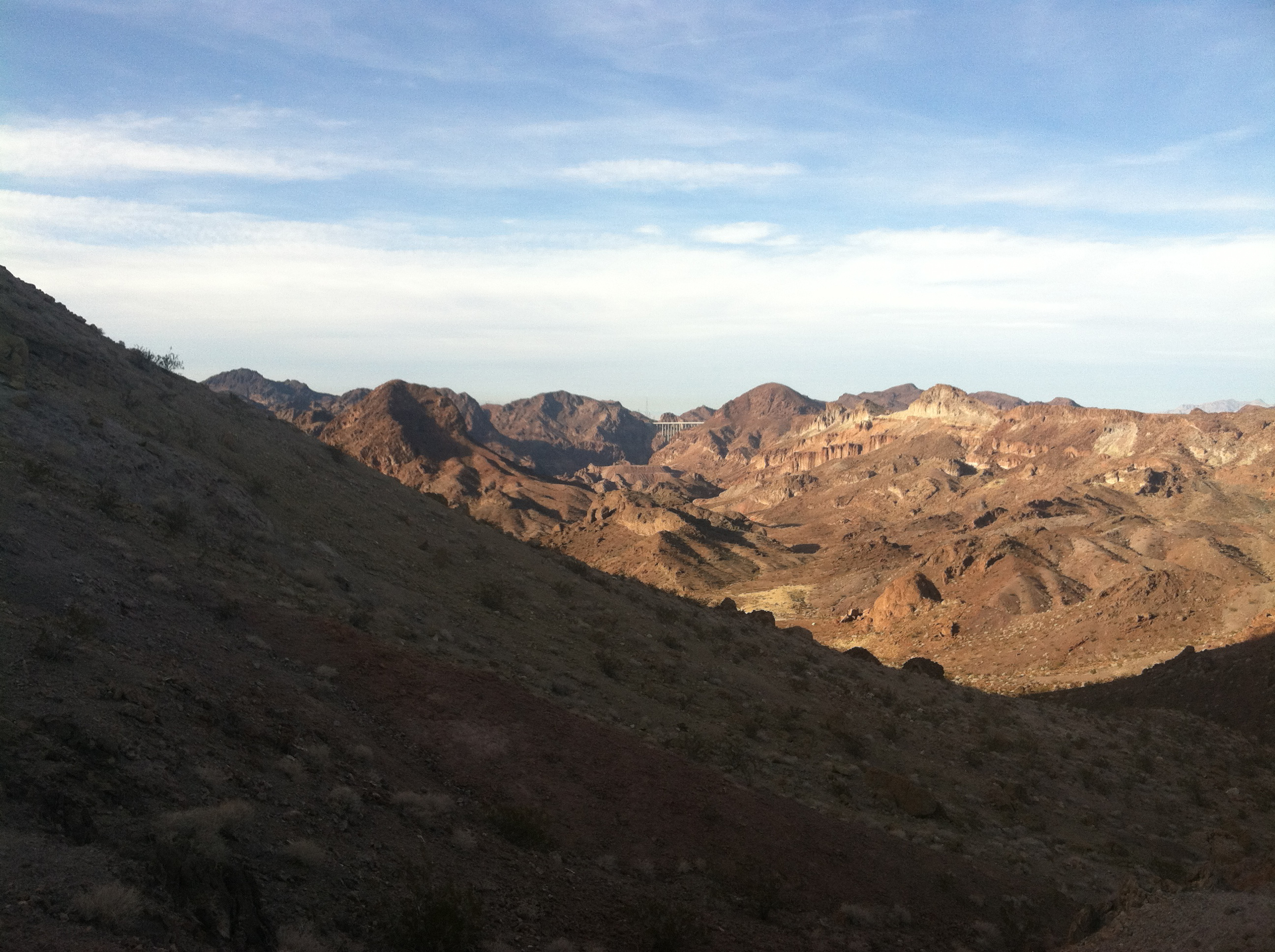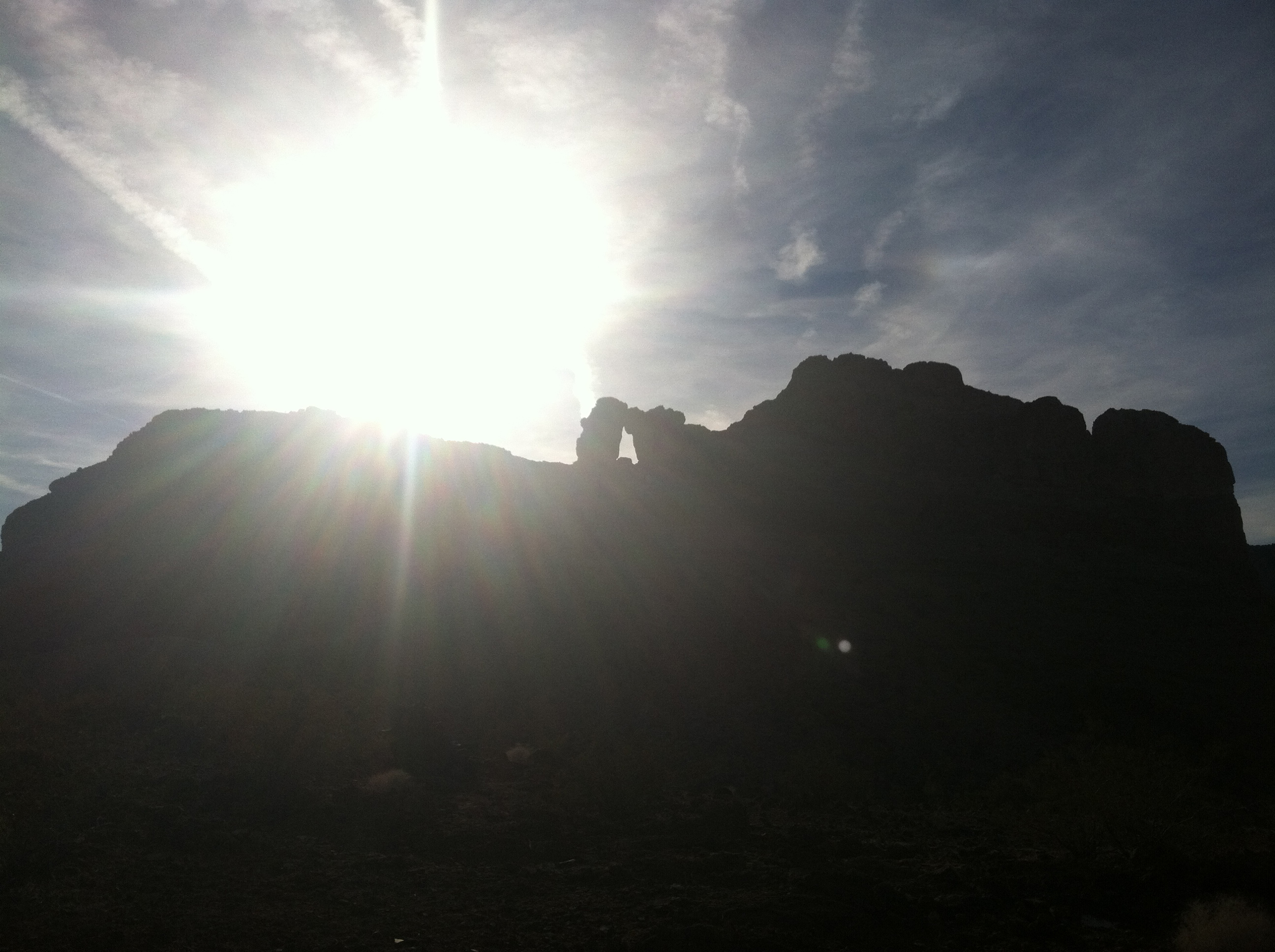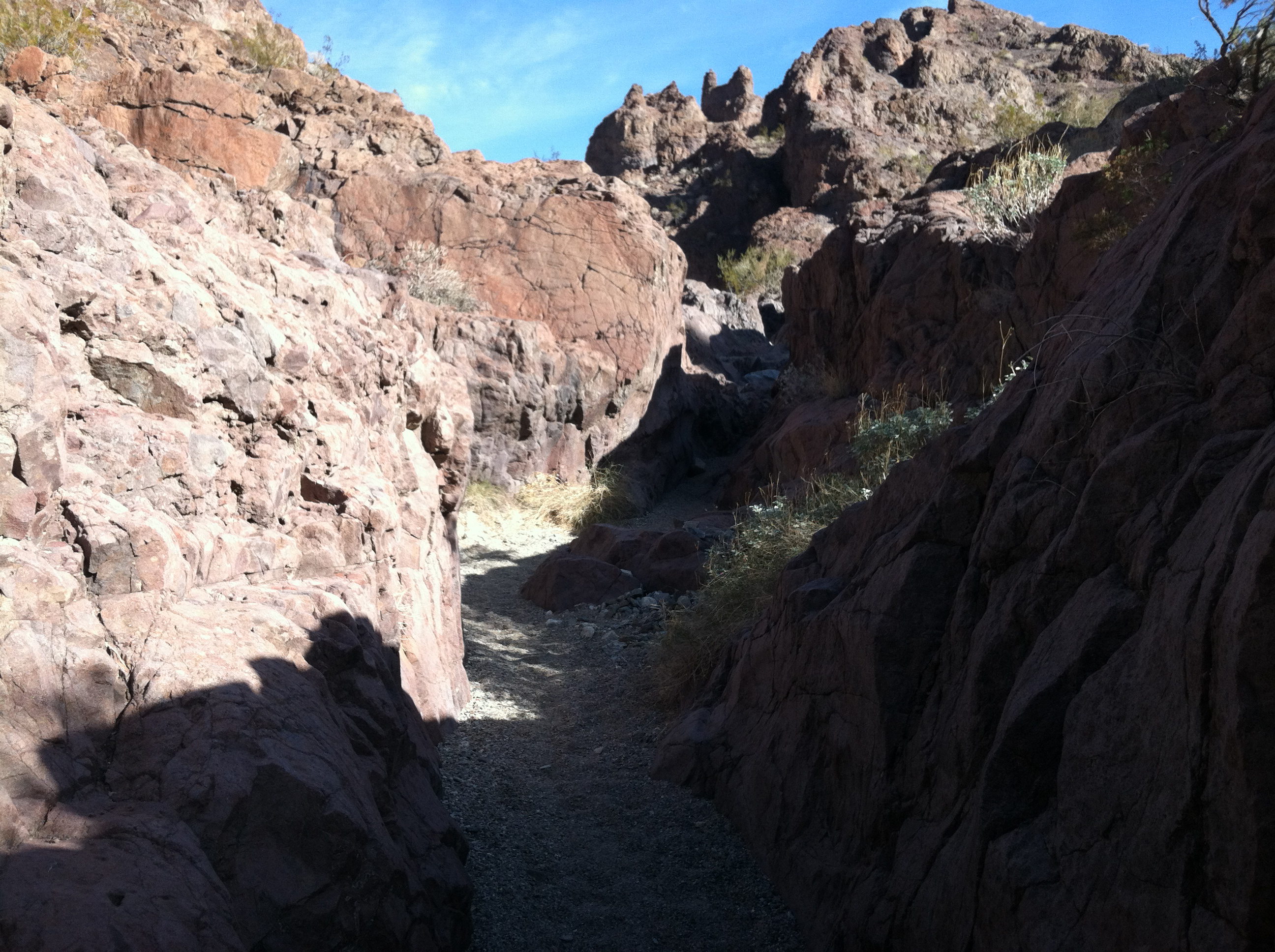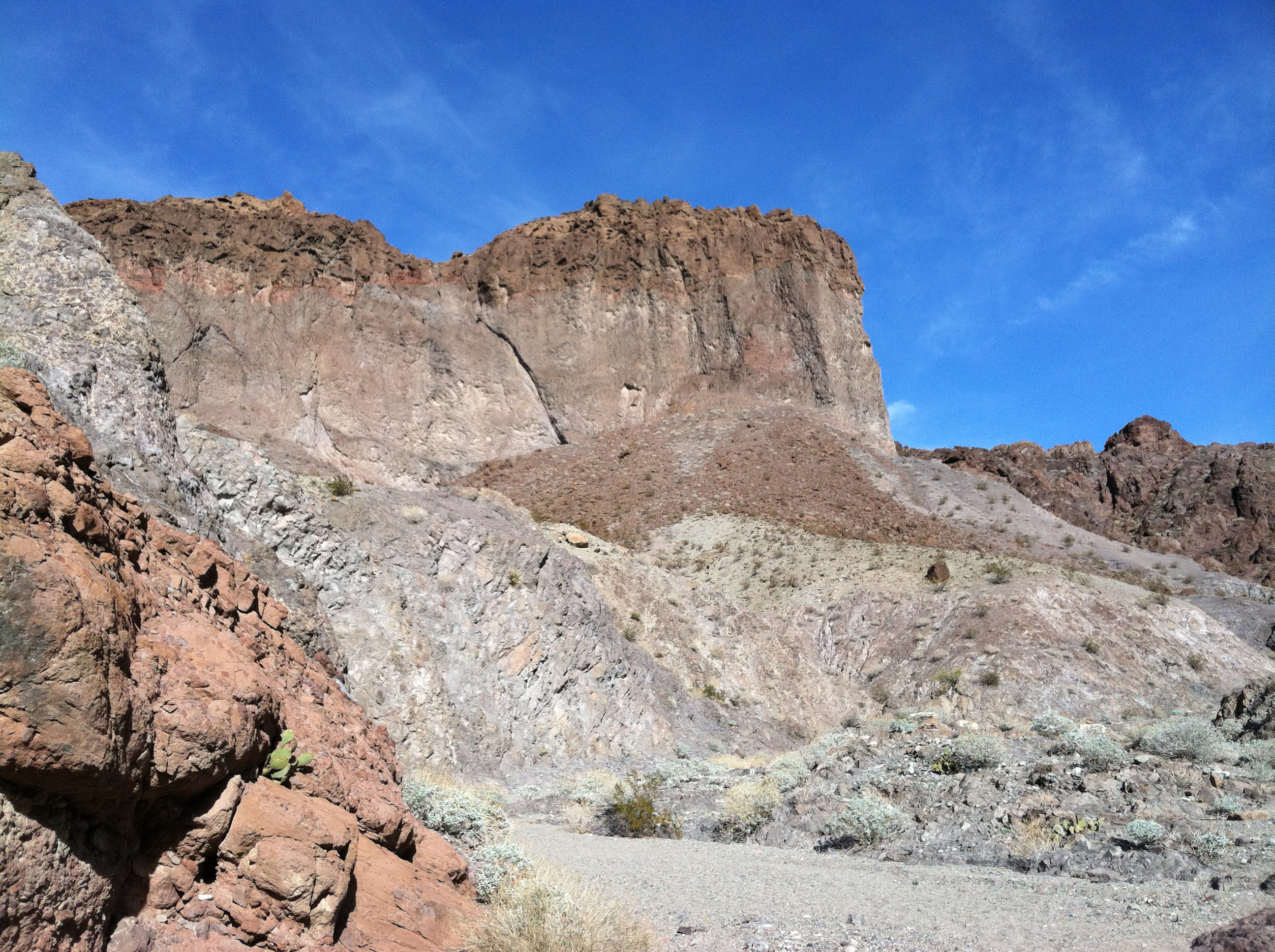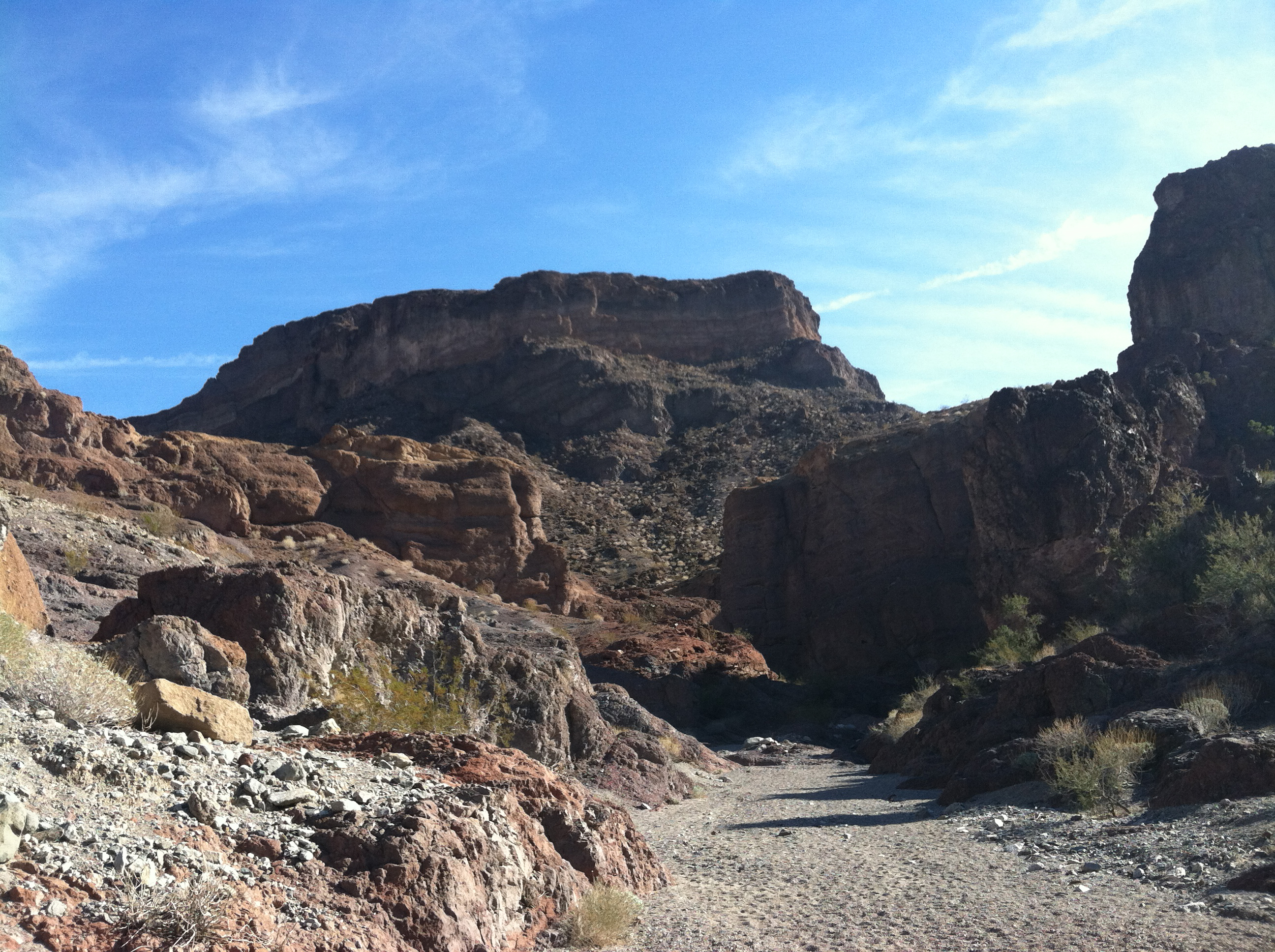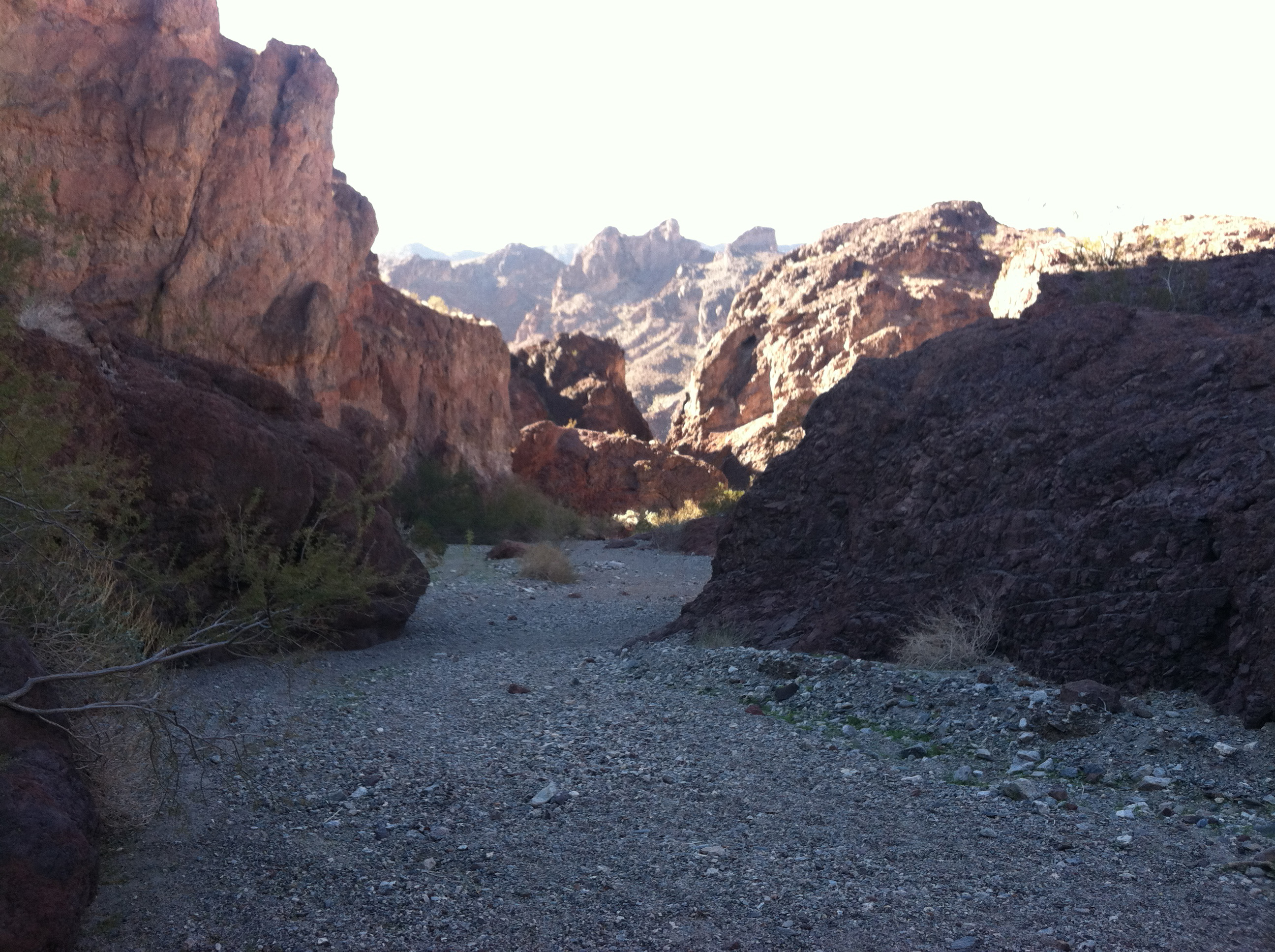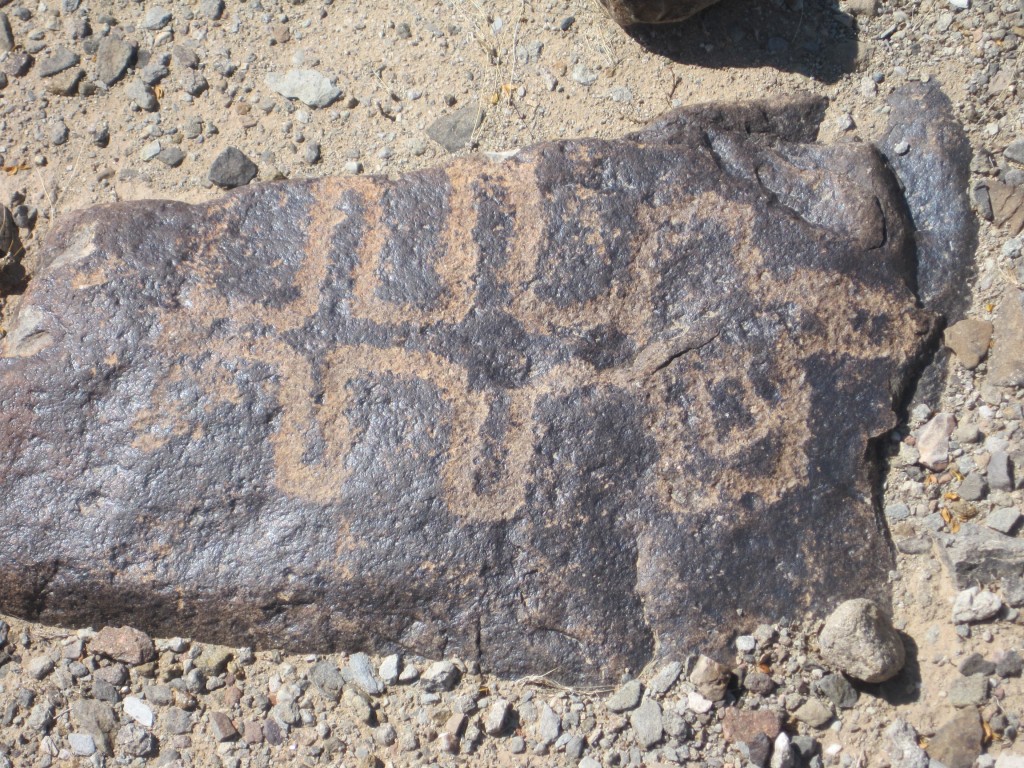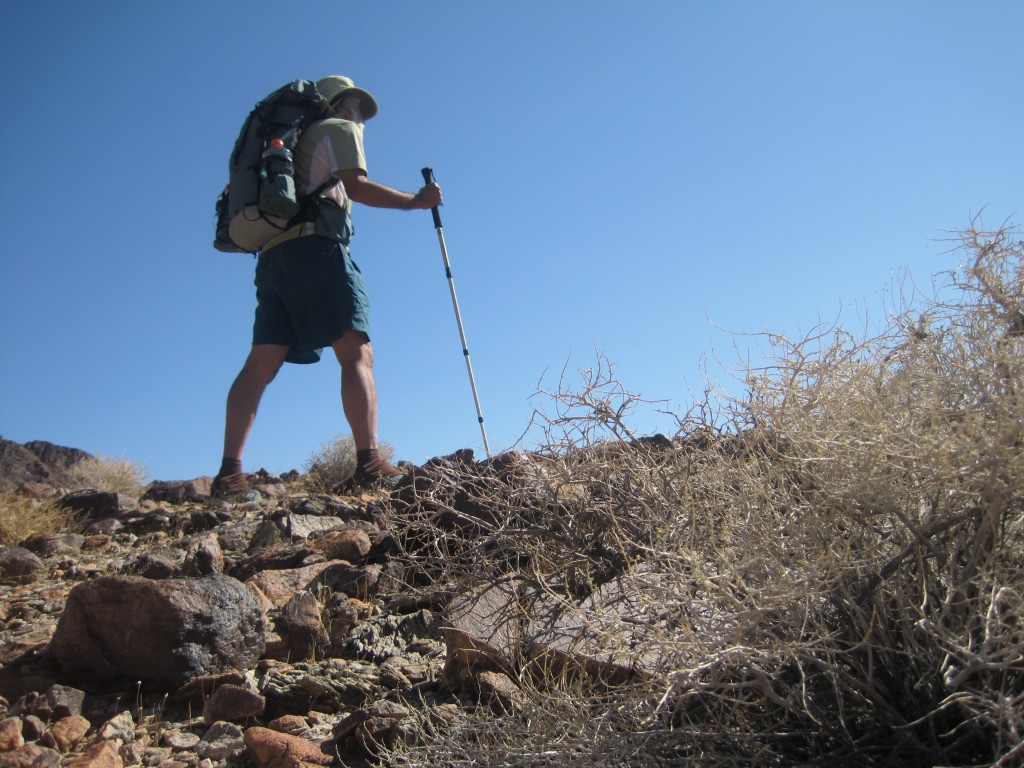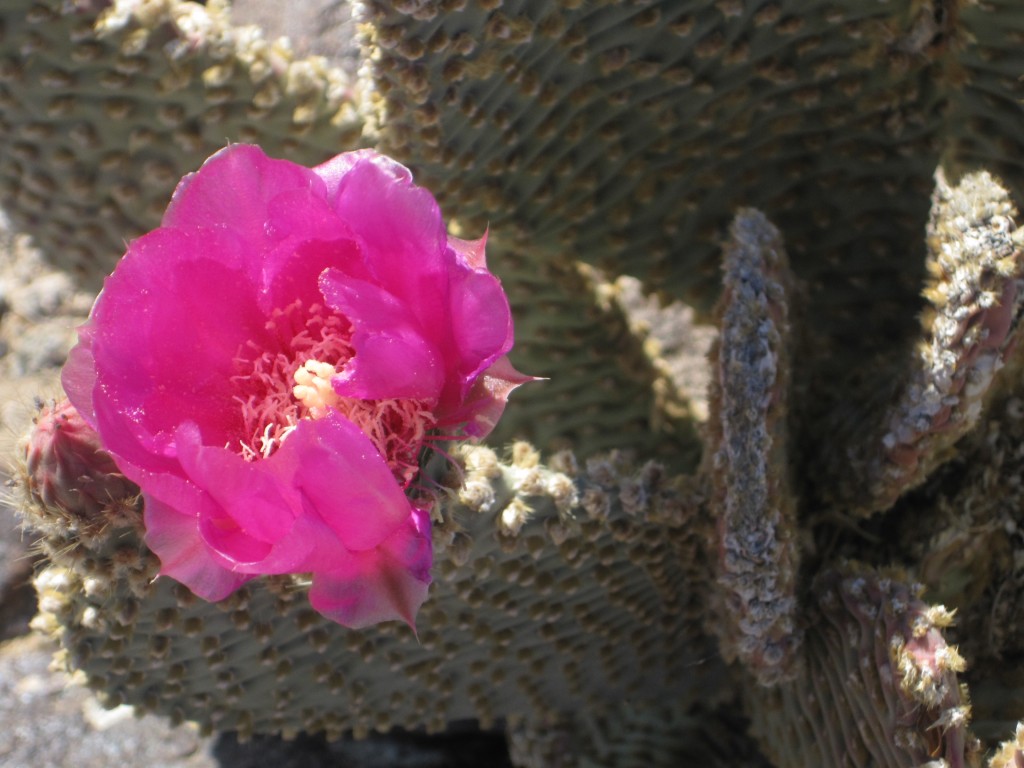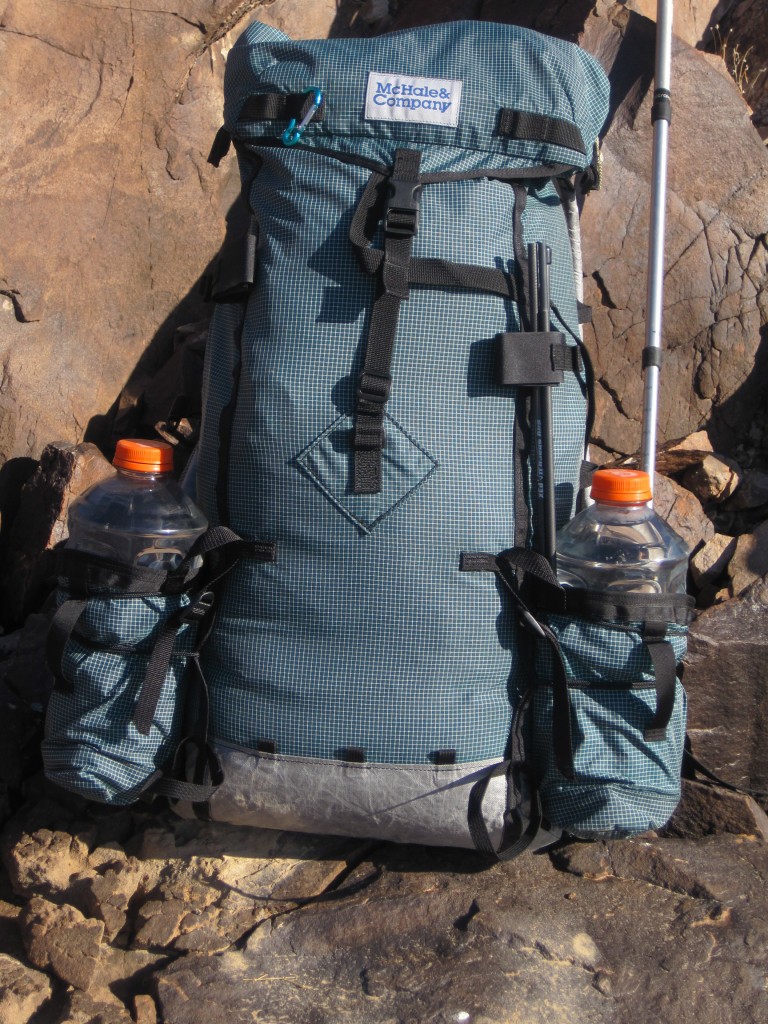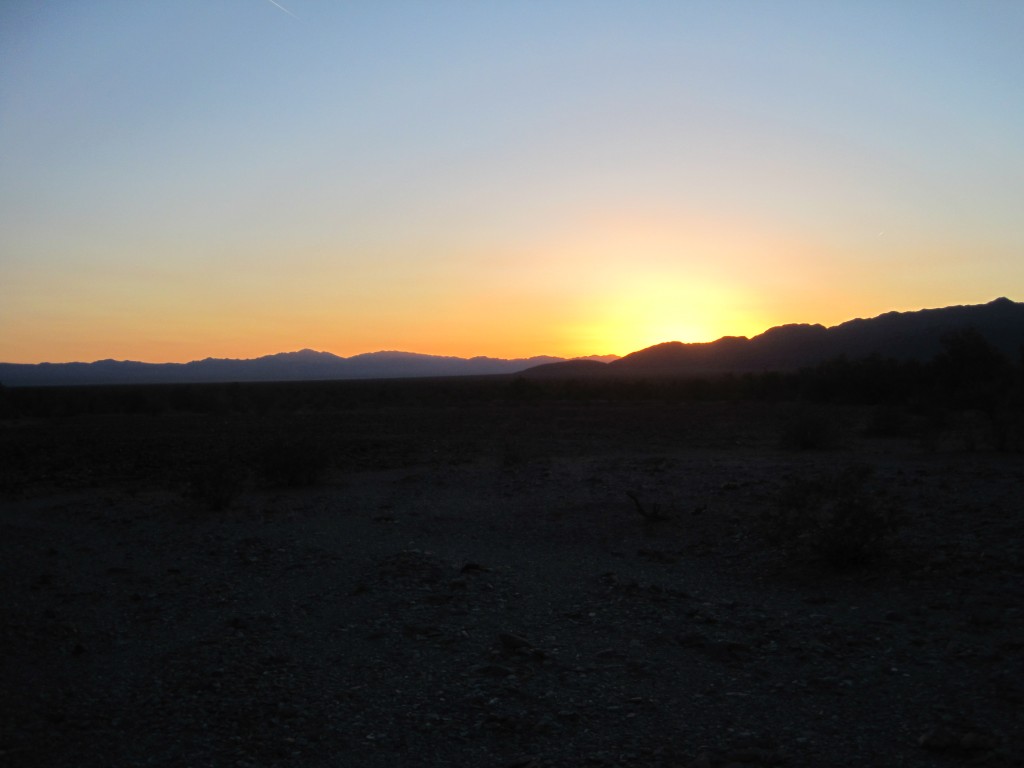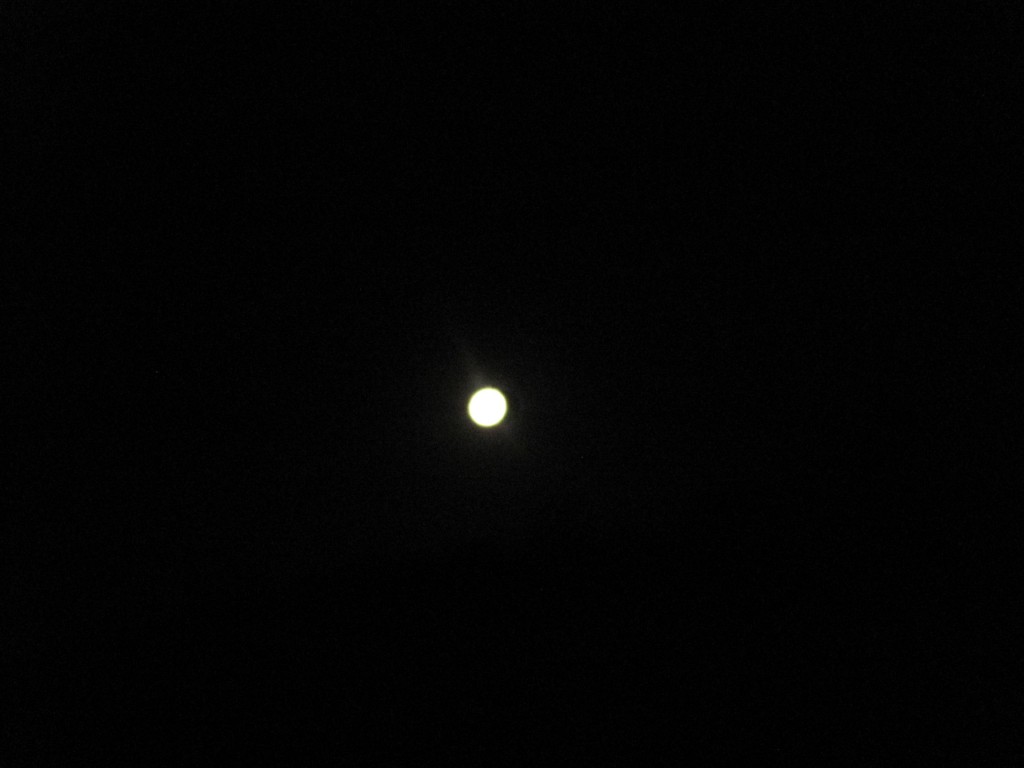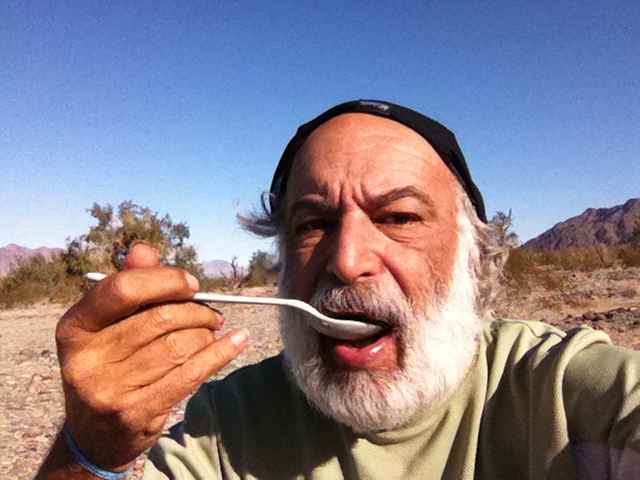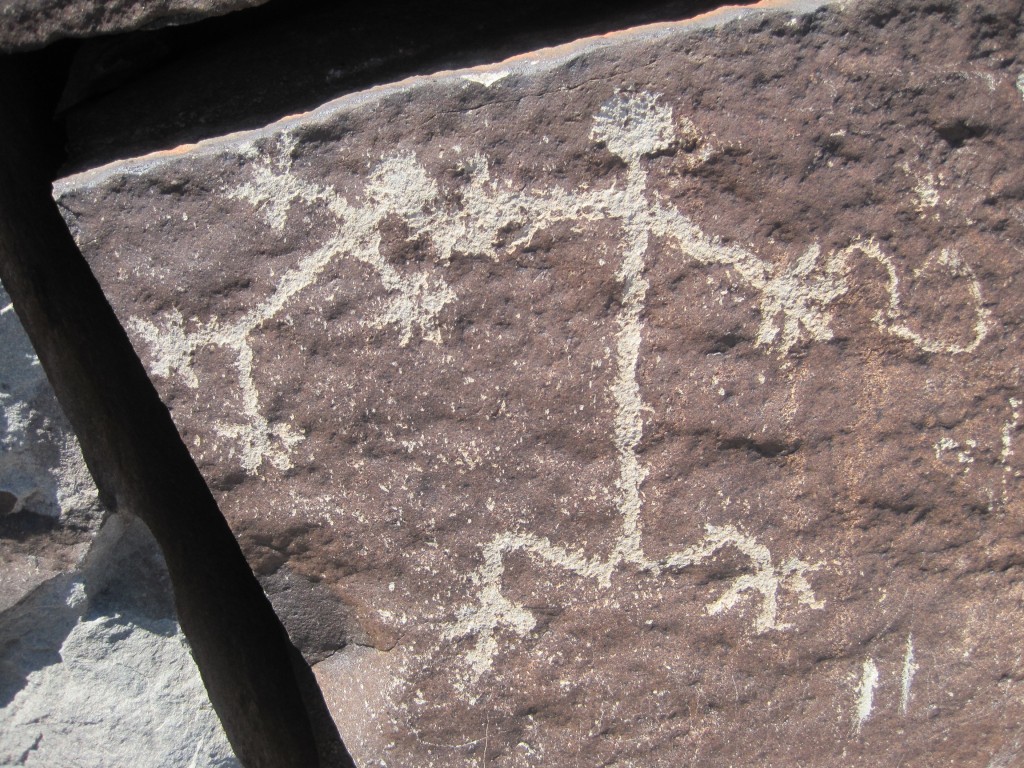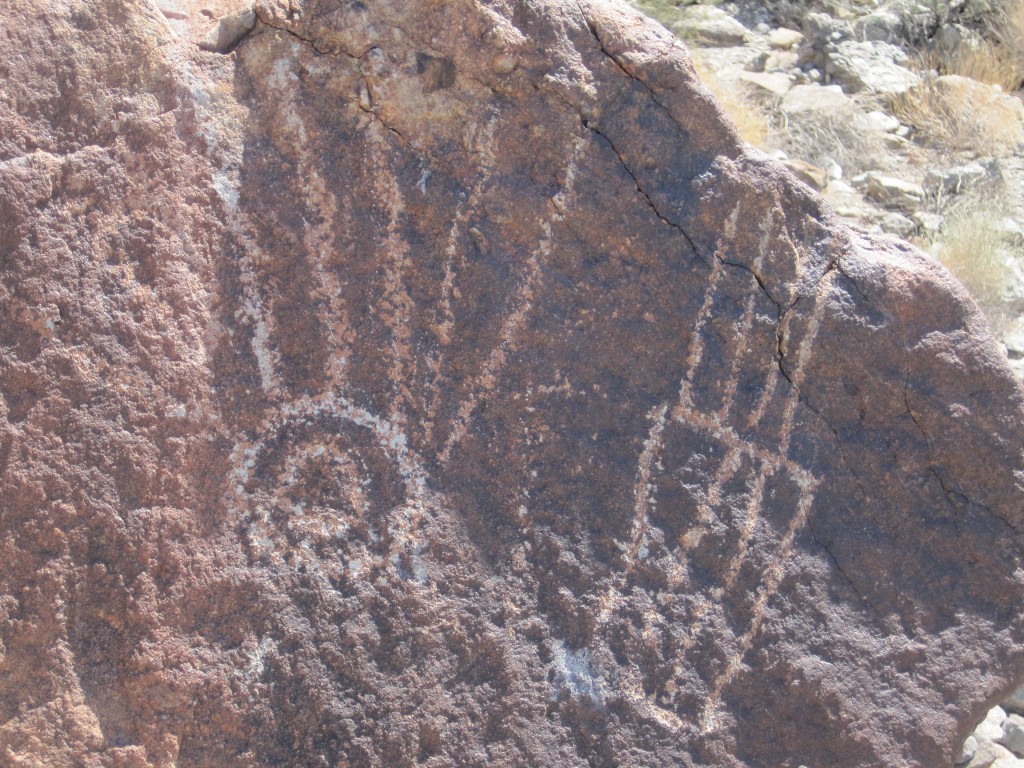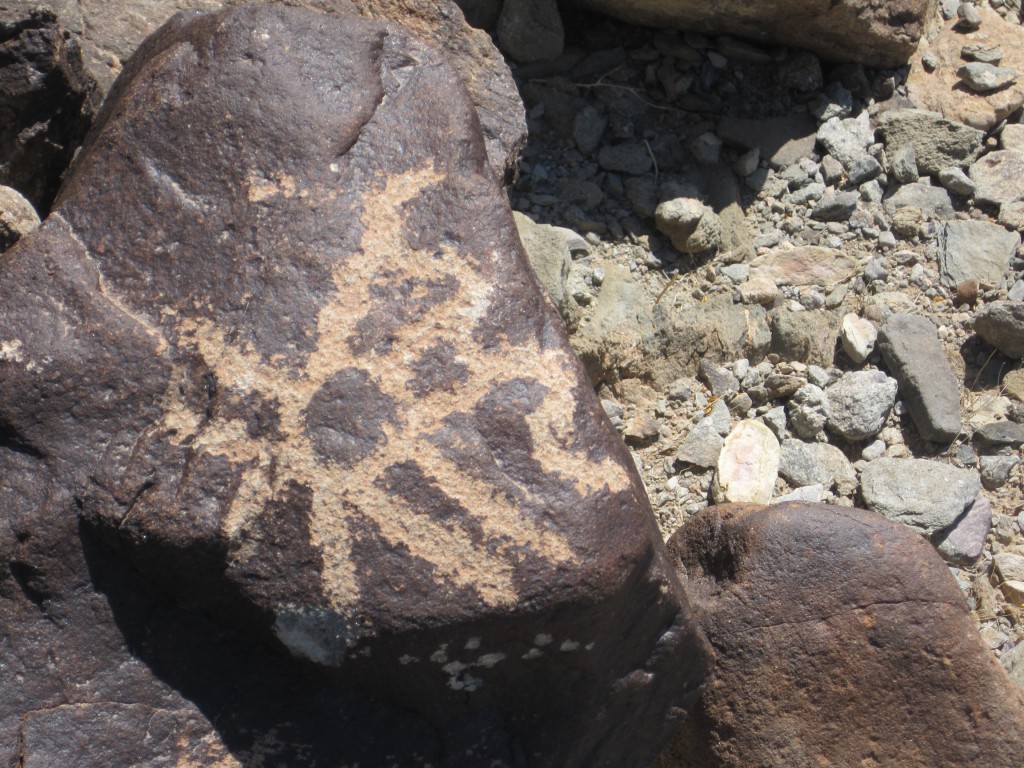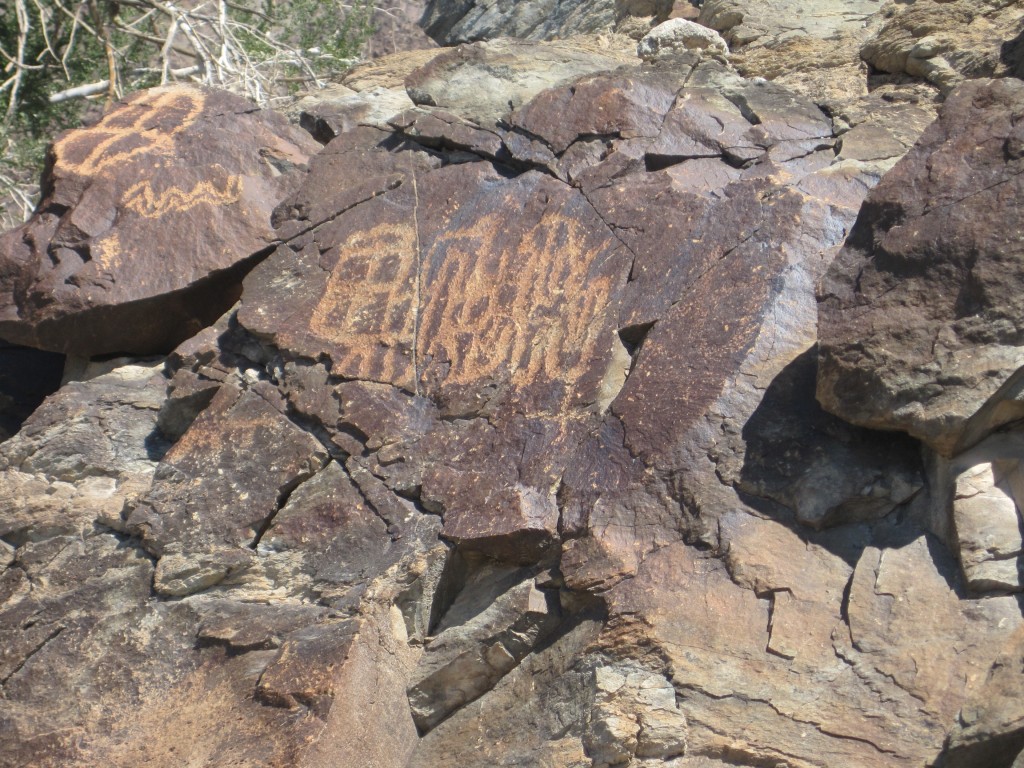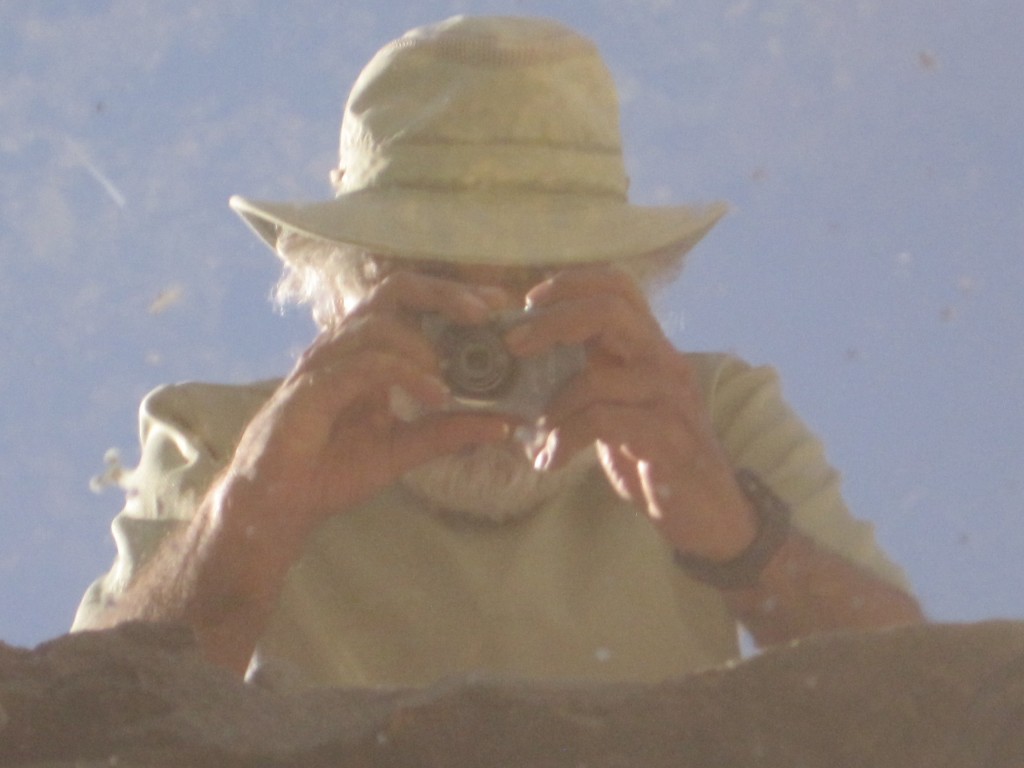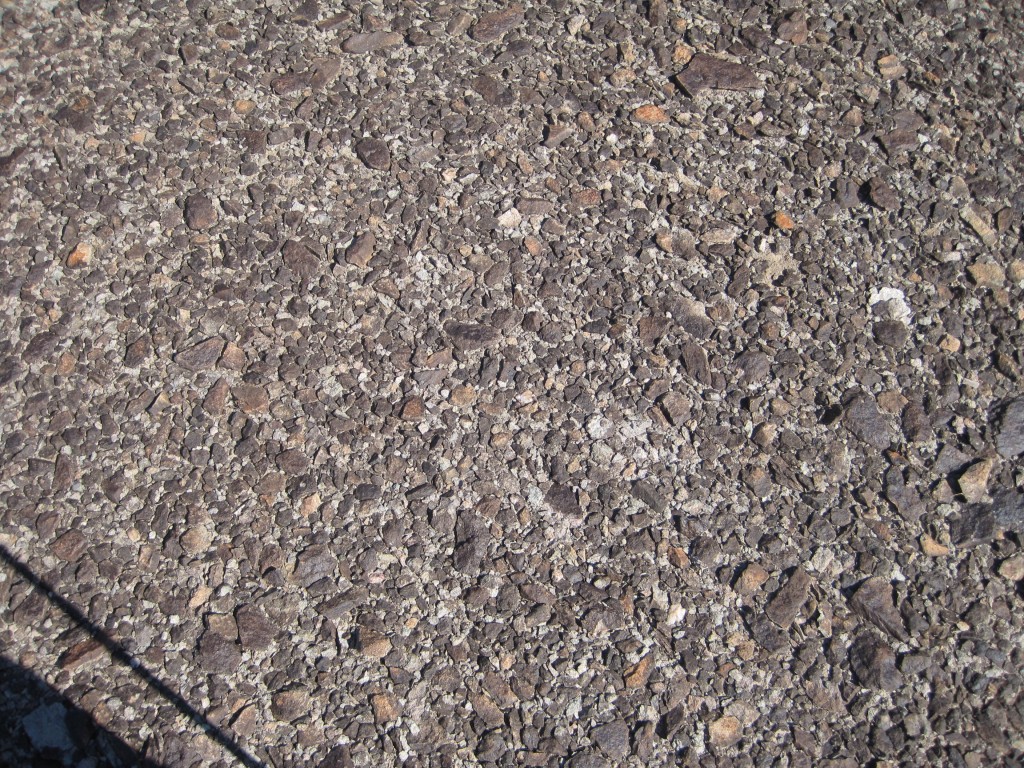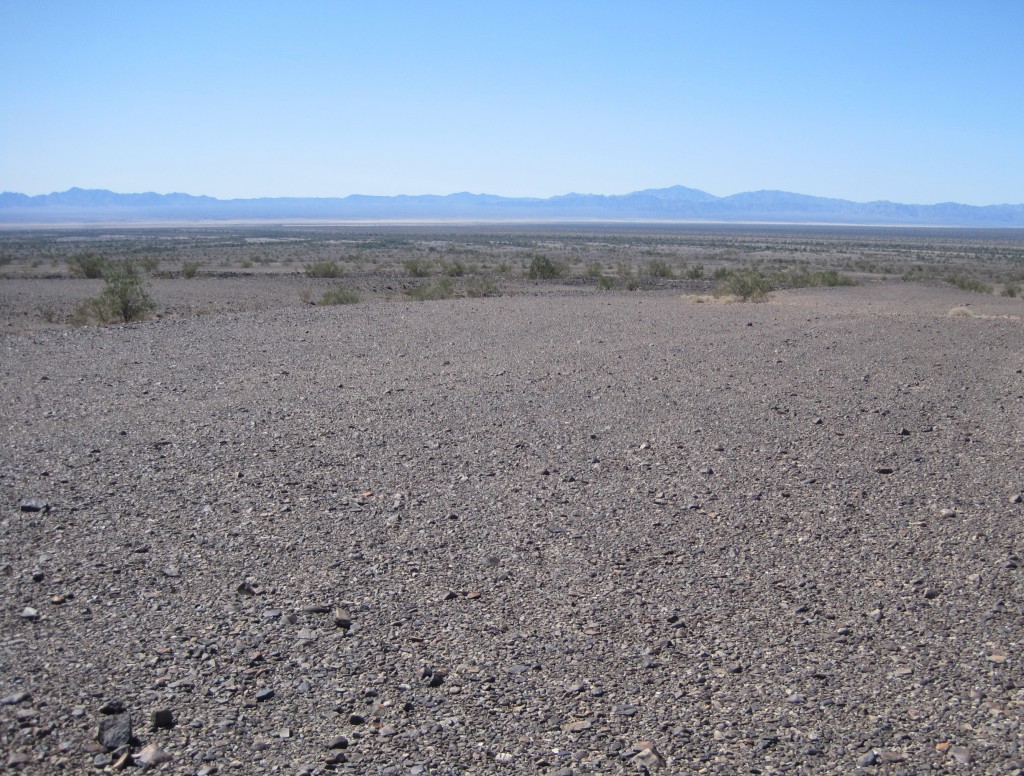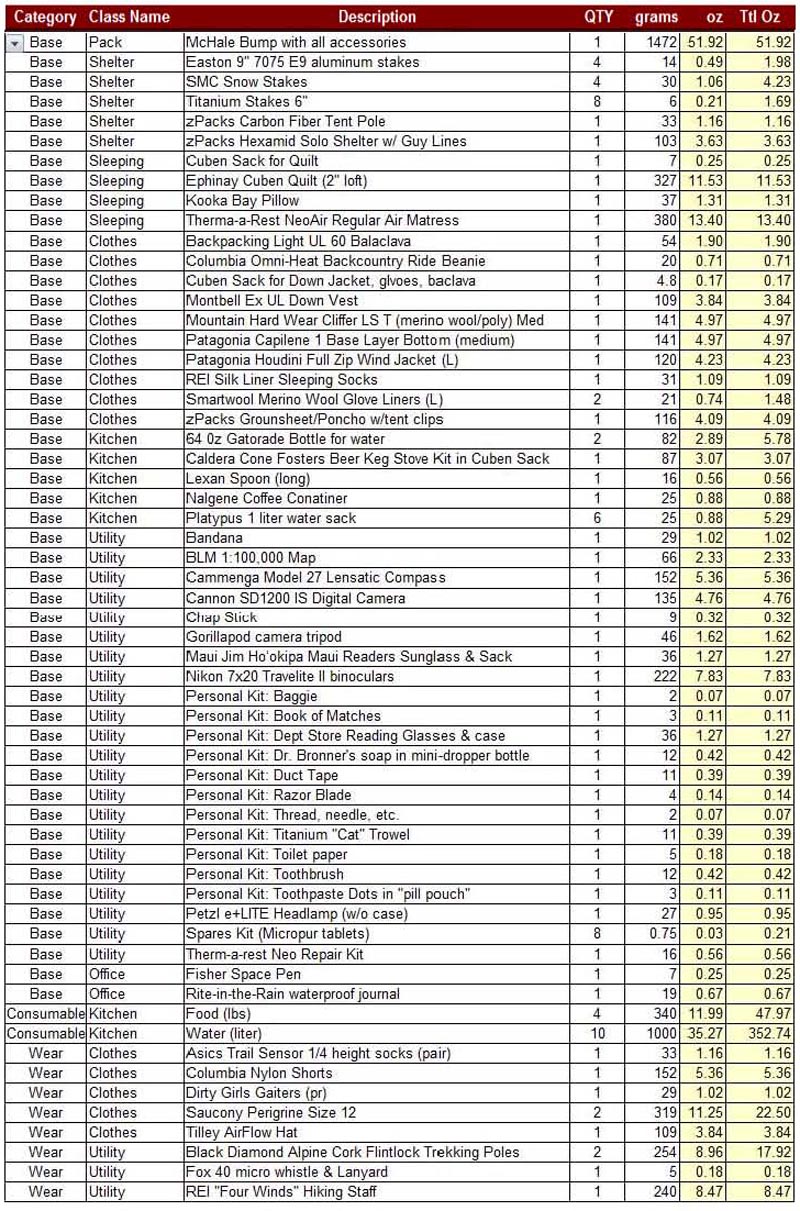Category Archives: Backpack Trip Report
Lake Mead Walk-about (2011)
Dad’s Christmas Vacation 2011
FOR NICOLE AND JOE
Backpacking Lake Mead Recreation Area
My Christmas present from Joyce was a “kitchen pass” to go backpacking between Christmas and New Year’s. The week before this we were camping at Lake Mead in the tent trailer.
Usually I hike this time of year in the Lake Mead area of Nevada. But this year I decided to hike into Arizona; into and near several canyons near the Colorado River. Since this is all desert, I would replenish my water every two days working back and forth from the river.
Preparation for the trip was just loading my backpack. Once I got to Nevada, I planned on stopping at the Lake Mead Visitor’s center for the maps I would need. I have been there before and they have a good selection of USGS Topographic maps. Maps are critical, since I would be hiking in the backcountry where there are almost no trails and few people venture to some of the places I would be in. Also, there is no cell phone coverage. The Visitor Center had closed down 18 months ago for remodeling, so I assumed (silly me) that it would be open. Well, it was closed. Still under construction; Amazing! It took 3 years to build Hoover Dam, and the government cannot remodel a small building in 18 months. So I drove to the district office in Boulder City, and they could not sell me any maps because they are in storage and no one knows where. But I could buy plenty of souvenirs. Made a few phone calls, and no maps anywhere. Okay, plan B – I loaded maps onto my iPhone. Kind of risky, because dead batteries or breaking it could be a bad thing. Biggest worry was dead batteries. The morning of the trip, I double-checked all my equipment and NO camera. I forgot it. Well, I could use the iPhone as a camera and risk more chances of a dead battery or breaking it, or drive to Las Vegas and buy a new camera. I decided to risk it.
The start of the hike started from the campground. I hiked through 4 old railroad tunnels cut into the mountains above Hoover dam that were used to bring supplies and construction materials to the dam site. From here I worked my way down to the Dam, walked across it and then walked several miles to a plateau high above the Colorado River, so I could determine where I wanted to go.
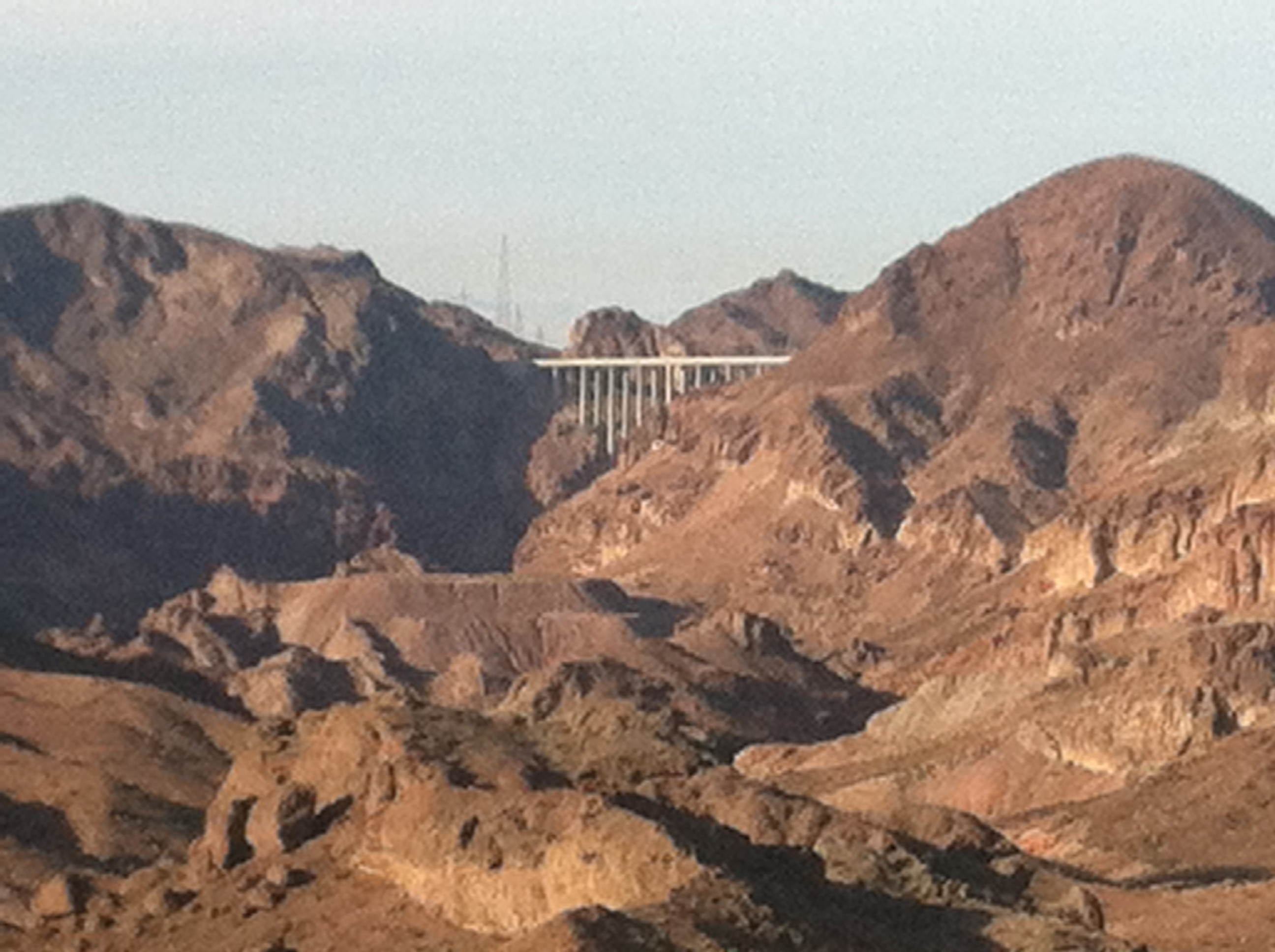 Starting point of hike is behind the hill on the left.
Starting point of hike is behind the hill on the left.
I would be walking another mile or so from the vantage point I took the picture of the bridge (above), to get a view of the Colorado River and confirm possible routes to water.The trip started from behind the mountain on the left of this picture. The bridge is the Highway 93 by-pass that diverts thru-traffic away from Hoover Dam, in response to concerns for Terrorist attacks on the dam, as a result of 9-11.
The bridge took 8 years to build, in contrast to Hoover Dam, which took only 5 years to complete. Progress!!
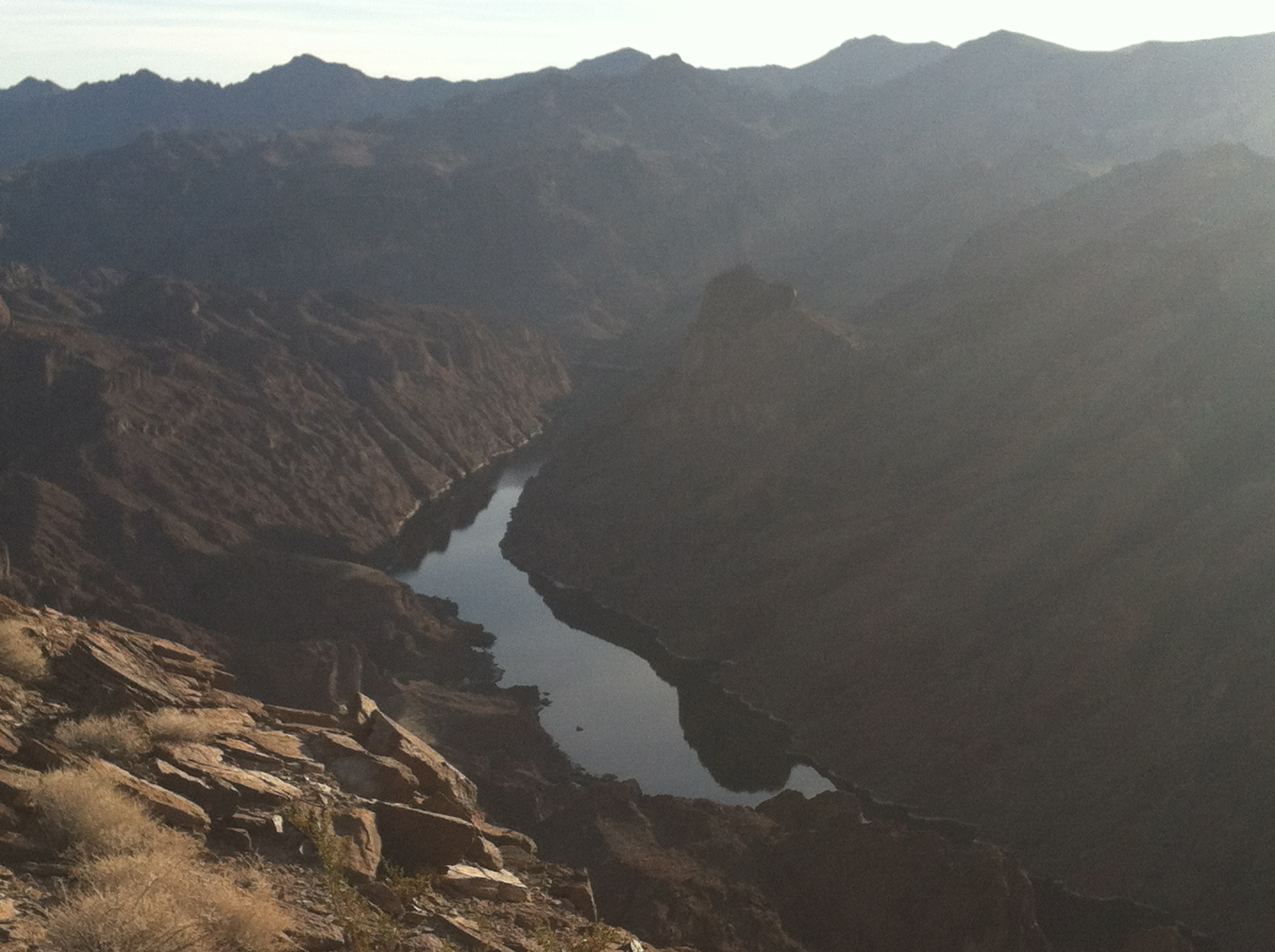 Scouting for a route down to the Colorado River
Scouting for a route down to the Colorado River
One thousand feet above the river and no easy way down from here. However, in the left center of the picture is a long canyon that looks like it has easy access, and the phone map confirms it. This means I am going to have to loop around to get to it. So I head east and what do I see?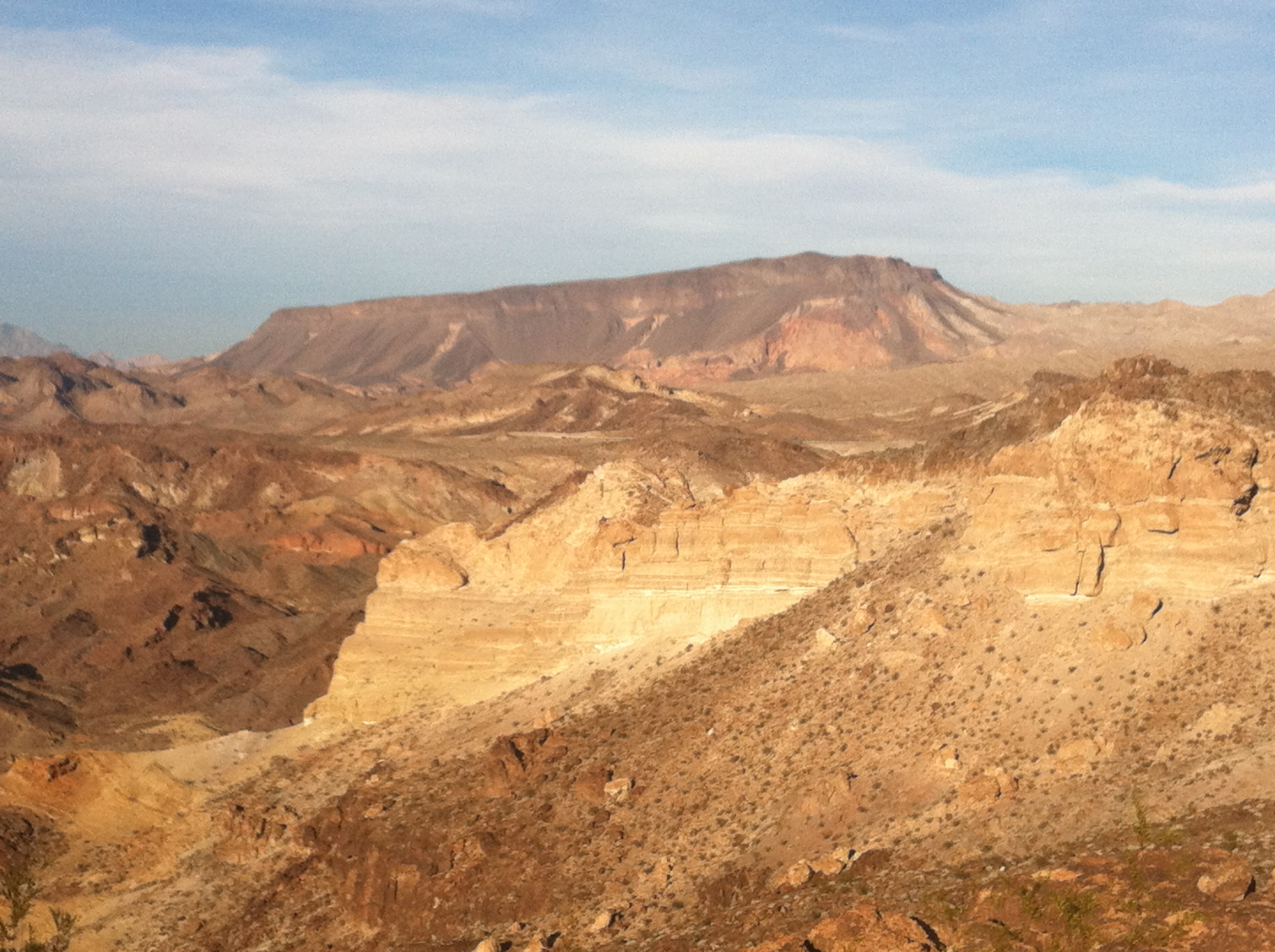 Fortification Hill
Fortification Hill
This! The map says it is Fortification Hill, but no trails are marked on the map. But it is just sitting there waiting for me to climb it. It is going to be a two day hike there and back to a water source. Not a smart idea to do when one is hiking solo, but then who said I was smart? Later I would find out that this huge plateau was formed by an extinct volcano and parts of the crater are still visible, but filled with rock and dirt.
It looks like the right side can be climbed, but the top looks vertical. Only one way to find out!
A three mile hike takes me to a dirt road that travels to left of Fortification Hill and eventually to the shore of Lake Mead. I plan on following the road for a couple of miles. Once on the dirt road, I find that is not the way to go, because there are a few people driving on the road. Aside from the dust their vehicles create, they keep stopping and ask me unbelievable questions.
Tourist #1: Is this the way to the Dam?
“No. Hoover Dam was built 75 years ago. Don’t you think they would have built an asphalt road by now? Go back a few miles and turn right when you see the sign, Hoover Dam, with an arrow pointing right.”
Tourist #2: You aren’t going to sleep out there are you?
“No, I am walking non-stop to Phoenix. It is only 250 miles away.”
Tourist #3: You aren’t hiking alone are you?
“Of course not. Can’t you see Harvey my pet rabbit?
Tourist #4: Is there water ahead?
“Yes. Drive about 3 miles down the road. You will find 3.8 trillion gallons of water at the end of the road.
Tourist #5: Hey! Can my Civic make it down the road?
“No, the sign back a couple miles ago said high clearance 4WD vehicles only. You have neither.
Tourist #6: Is your pack heavy?
“No, it is filled with a secret formula of gases. 79% nitrogen, 21% oxygen, and a few trace gases make it completely weightless.
I couldn’t take it any longer, so I headed cross country which meant climbing in and out of 3 small canyons to get to the base of Fortification Hill. By now it was getting dark, so I laid out my groundsheet and quilt, and cooked dinner. Temperature would get down just below freezing each night this week.
In the morning it was chilly, so I took my time with breakfast waiting for the sun to hit me. As I sat sipping my coffee, I saw 7 young male Big Horn Sheep practicing head-butting on a ridge. Since it was too far to capture on my phone, I got up and moved closer. They sensed my movements and just stood and watched me. I would see two more of these magnificent animals later in the day.
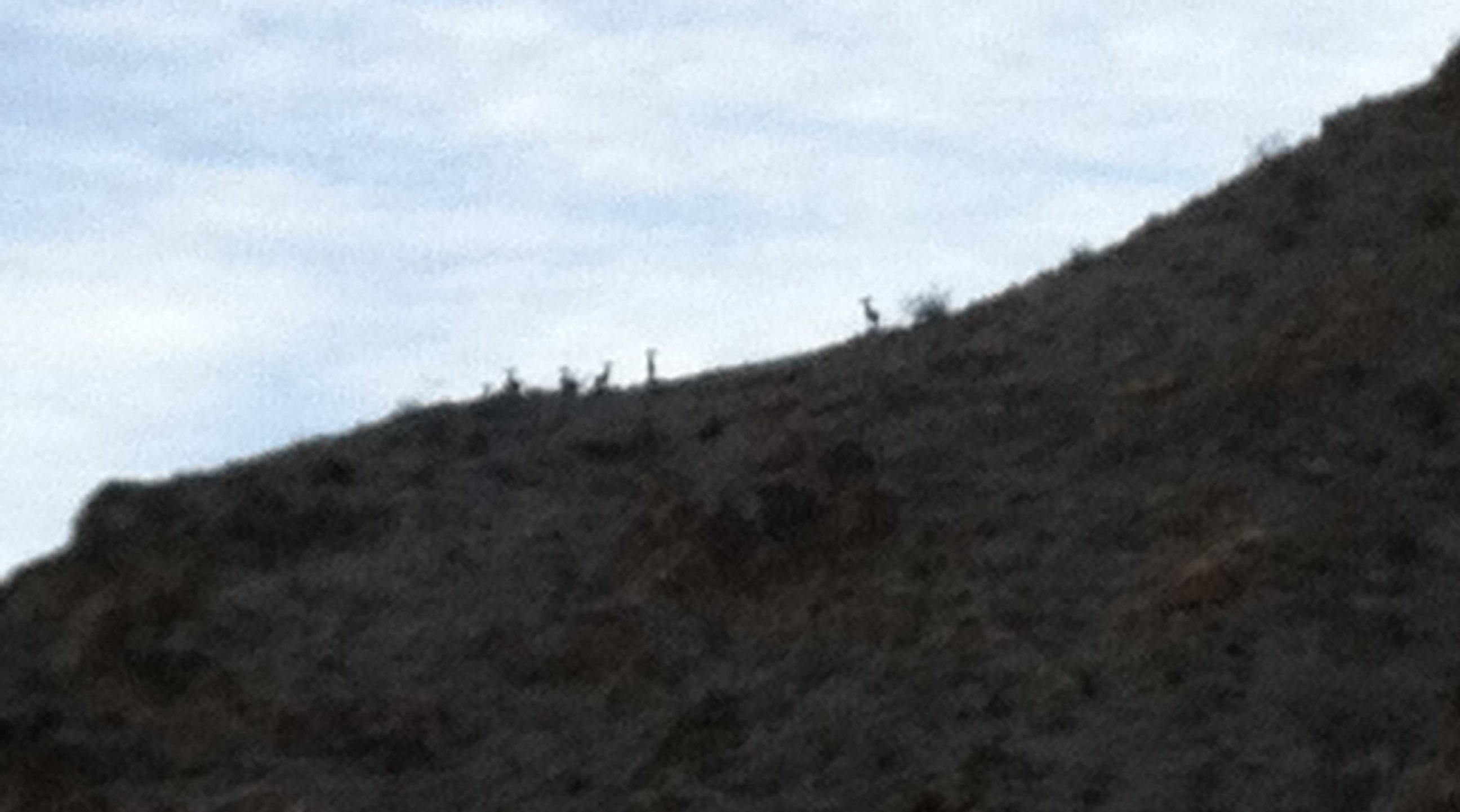 Big Horn Rams practicing head-butting
Big Horn Rams practicing head-butting
By now I needed to get going. I still had not seen a route up the hill, and then it would be over 12 miles to loop back down to the river. Packed up my gear and followed a wash around the south end of the hill. Soon I came to a side canyon that was flowing down from the hill with a sign that said, “Trail Not Maintained. Hike At Your Own Risk.” Perfect, my kind of trail. I followed a faint trail up the canyon, which disappeared in about 800 meters. But it must have been a trail to the top. So I climbed a small ridge that ran parallel to the canyon and found a steep trail that zip-zagged up to the rock face near the top.
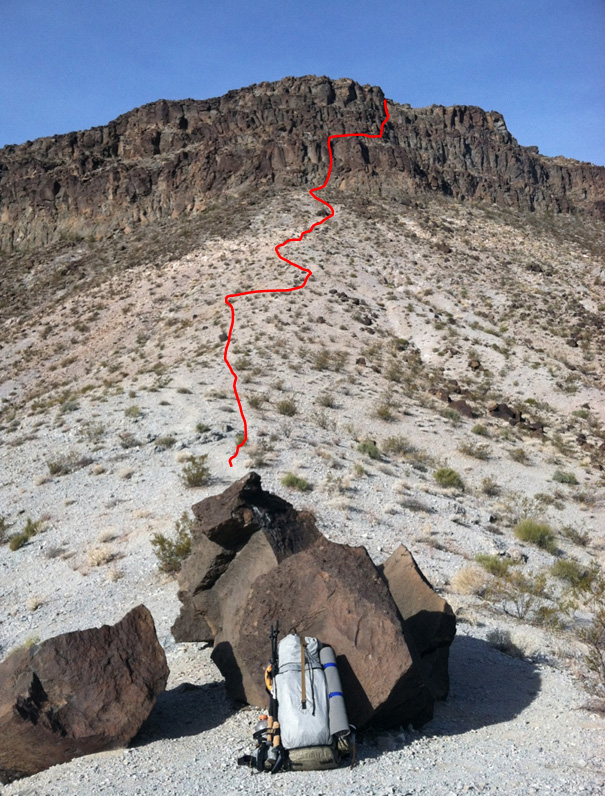 Approach to Fortification Hill from the ridge-line
Approach to Fortification Hill from the ridge-line
It only took a few minutes to get to the vertical cliff past those huge boulders on the previous page, and I found a route that entailed relatively easy climbing, other than a slip that would turn things into a bad day. Once on the top, I found a relatively flat mesa about ½ mile wide and over a mile long. About a mile ahead was a small summit with a well marked trail in the volcanic rock. For the most part the entire plateau was all volcanic rock with a few plants growing here and there.
This moonscape looking rock formation is what the entire mesa looked like, only most of the rocks were much smaller.It only took a few minutes to get to the vertical cliff past those huge boulders on the previous page, and I found a route that entailed relatively easy climbing, other than a slip that would turn things into a bad day. Once on the top, I found a relatively flat mesa about ½ mile wide and over a mile long. About a mile ahead was a small summit with a well marked trail in the volcanic rock. For the most part the entire plateau was all volcanic rock with a few plants growing here and there.
Here are some views from my vantage point on Fortification Hill
Las Vegas
Hyw 93 Bridge & Hoover Dam using the zoom in my iPhone – sure wish I had brought my camera!
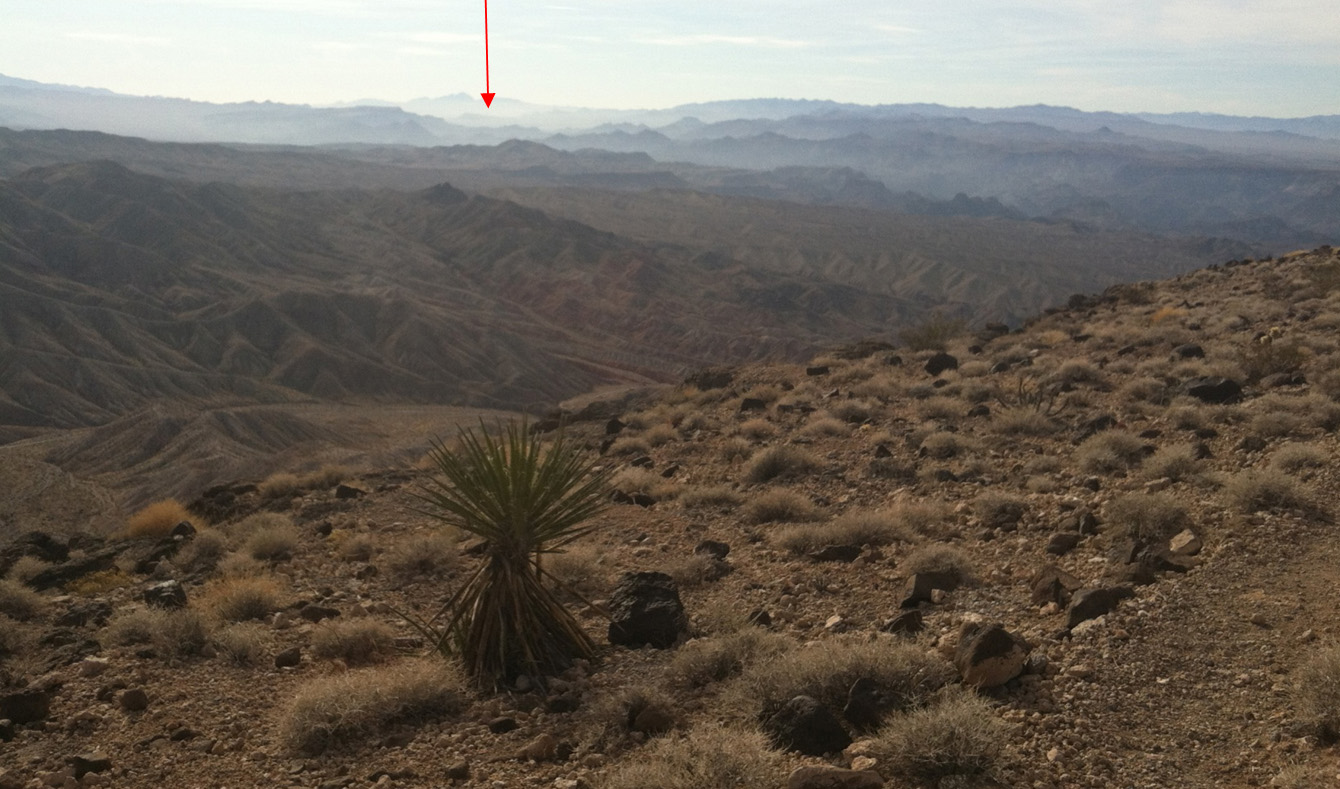 Looking west towards the Colorado River from Fortification Hill
Looking west towards the Colorado River from Fortification Hill
After taking pictures I headed back down to the mouth of the canyon and ate lunch. It was now 12:30 PM and I needed to get to the river before dark, which was 12 miles in 4 hours or so. Ten of those miles were easy downhill ones, in a large sandy wash. I got to the river just before 5 at dusk, with about a half a cup of water to spare. So I had averaged 3 miles per hours, pretty good… but then most of it was downhill. The last 2 miles of this section was fabulous – a long slot canyon with walls several hundred feet tall. Pictures below:
Since it was almost dark when I got to the River, I did not really know what my campsite selection looked like until I awoke in the morning. It was nice, if I don’t say so myself!
So this is the beginning of Day 3, which would turn out to be the most unusual day of all.
The first order of business for Day 3 was to get out of the Colorado River gorge. The gorge got smaller as I went south, but there was no way out of my present spot unless I retraced my steps, swam down river, or found a way to hike out a canyon about ½ mile south of my night camp. So I chose, door #3. A little rock scrambling got me to where I thought the canyon should start, but I could not find the mouth of the canyon. Then I found a small seep of water and followed it. There were a few sections I had to climb some small “run-over’s” and then there was a 20 foot waterfall – dead end; except that someone had placed a ladder against the vertical rock. How convenient. So up I went. And then, here I found two small pools fed by a hot spring. Water temperature was at least 100F. So, it seemed like a good time to take a Jacuzzi!
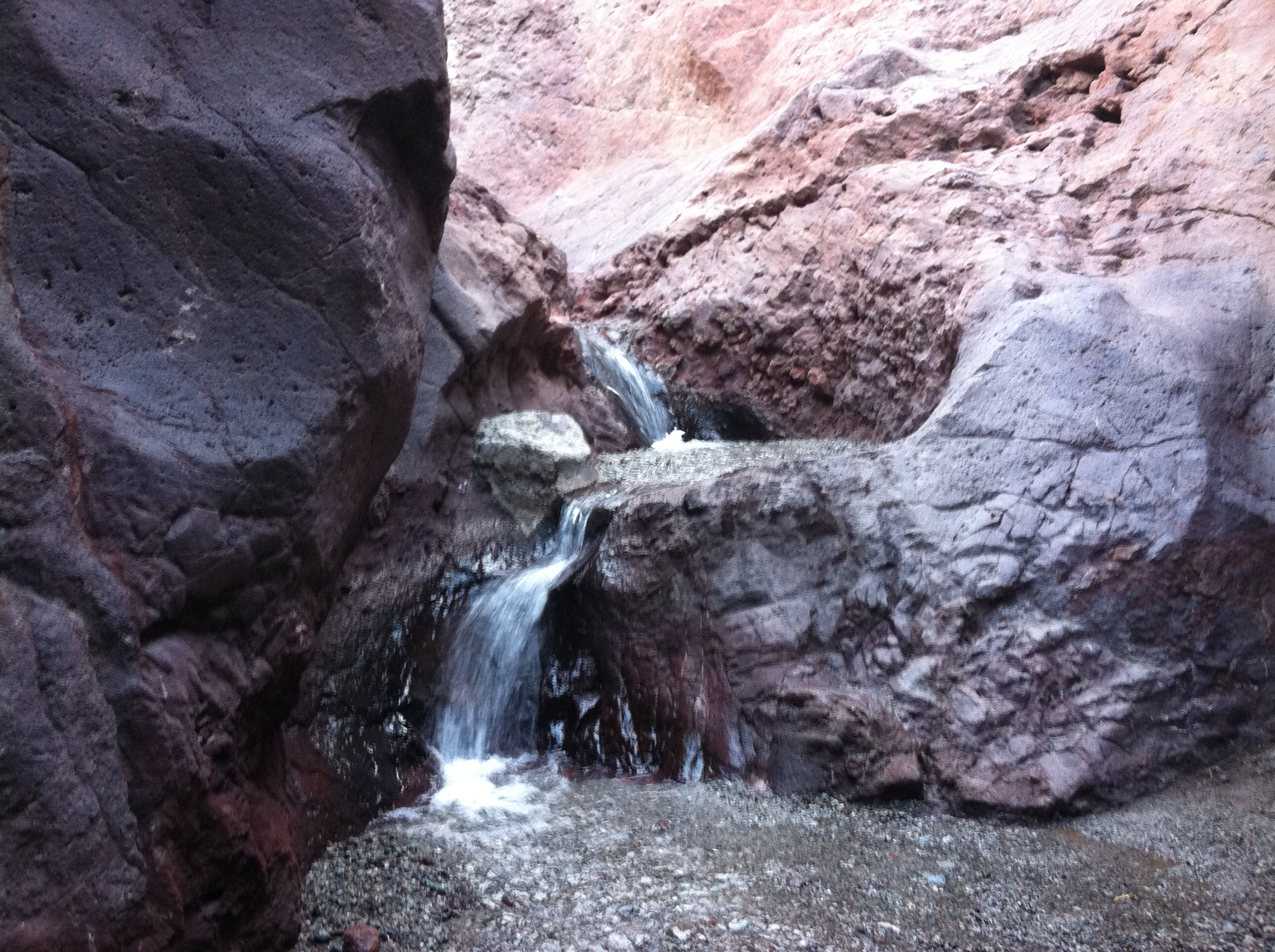 Stream coming down the steep canyon
Stream coming down the steep canyon
It was now around noon, my shoes were dry, so I decided to take a lunch break, clean the sand out of my shoes and put my socks back on. It had now been almost two full days since I had seen another person. So here I am sitting on a big rock and I hear footsteps. Look up and this guy, older than me, is coming down the wash. He was wearing water shoes and carrying a small day pack. That’s it. No clothes, completely naked. He said, “Hi,” and kept walking. I was going to take a picture of him walking away, but then I figured, how would I explain this to Joyce? Since I was hiking in shorts, I took off my shirt and socks, and wore my shoes sock-less. Really nice way to start the day. After a 30 minute soak, I put on my shirt, hoisted the backpack and headed up the canyon. Had to climb up a few small sections of slip-rock, and then it was easy going in a sandy wash, with a few sections of slot canyon work.
The rest of the trip was uneventful compared to the first three days, so here are a few pictures.
Love,
Dad.
P.S. Happy New Year!
Hike to a Secret Place
Hike to a Secret Place March 2012
INTRODUCTION
This probably going to be one of the strangest trip reports you have ever read. First, I am not going to tell you where I went, and secondly, many of the descriptions and normal logistics will be purposely camouflaged. The area of this hike is rich in Native American Petroglyphs, and sections have been heavily vandalized in the past – over 150 years worth of vandalism.
The area is in a designated Wilderness Area, and the government agencies charged with protecting these lands have limited enforcement resources. The good news is that the Wilderness Designation has significantly reduced travel in the area, by making the use of motorized and non-motorized vehicles illegal. I visited the two agencies that are responsible for managing the area a got little information. Either the employees just did not know anything, or it is policy not to divulge information. I did get all the information I needed for traveling in the area and what the rules are.
SECRET PLACES
I often avoid places that are well publicized on the Internet or which have been included in a published Trail Guide. Some of these publicized places have gems of solitude and beauty if one travels off the recommended “beaten path.” But to me, the absolute best places to go are areas that no one goes to visit – places without trails, without roads, without mention on the Internet, and without Trail Guide recommendations. These places offer solitude. They feature little or no trash, and often no footprints, not to mention a lack of people.
So how does one find a Secret Place?
First step is to get a big map. A State Road Atlas is excellent. Look at places that have few roads or cities around them. From there, go online and look at the USGS Topographical Maps (they are free), or better yet BLM maps (where available) are excellent at only $3.00 each. These maps are 1:100,000 scale. While they won’t tell you where the most exciting places are, over time you will learn to find them. Over the years, using this methodology, I have visited most of the mountains south of Death Valley to Mexico, and West of the Colorado River to the Pacific Ocean. There are dozens and dozens of mountain ranges in this vast area. Some so small you can circumnavigate them in a day and others so large it takes months to truly know them. Some of these mountains I have traveled extensively and intimately; visiting every side canyon, ridgeline and high peak. Others I have just scratched the surface, and placed on my “To Do” list. I do not have a checklist of places to go, but often just head to a place I have never been before.
This trip was my second time in this particular mountain range. I remember the first time distinctly. It was soon after my daughter, Nicole, was born; 1985. On that trip I had crested a desert pass, and below me lay a large “bajada.” A bajada is an alluvial fan of sand, rocks and debris that turns into a fairly flat plain. This bajada was formed by two small mountain ranges and I would be traveling through this to my next water source, which was between 20 and 30 miles away. But I was running short of water. I would either need to rest during the day and travel at night, or find water in either of these two mountain ranges. My map only showed a “dry spring” in one of the ranges. Most would say it was hardly worth the extra time and effort to check it out with little expectation of water. As I traveled down the gentle slope of the bajada, I eventually was directly opposite of the dry spring, and my binoculars showed an abundance of greenery in the area of the spring. To me it was worth the two mile round trip to find out, plus if water was not available it looked like a cool place to rest in the heat of the day. Not only did I find water, but found hundreds, if not thousands, of Petroglyphs. Since I had a time schedule to keep, I could only place a note in my mind that this was a place to come back and explore further. In the early 1990’s this area was designated an official Wilderness Area, giving me hope that it would not be harmed for future generations.
THE PURPOSE OF THIS TRIP
This trip had several purposes
- To walk around the entire mountain range, a hike that would take most people 3 or 4 days.
- Spend time exploring and photographing petroglyphs.
- A shakedown cruise for my new McHale Bump 32 backpack.
LOGISTICS AND PREPARATION
To get to my starting point of the hike, I would need to travel about 20 miles on dirt roads. Not knowing the condition of the roads, and knowing the dangers of this kind of back country driving, I loaded the
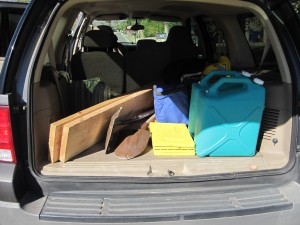
back of my SUV with 8 foot boards to be used a sand ramps in deep soft sand, several platforms for emergency work, 14 gallons of emergency water, air compressor, shovels, and extra tools. I got stuck in sand only one time, and two of the platforms got the vehicle moving in a few minutes.
WATER
This is the limiting factor in most deserts. The way I planned the route, I would need to find water in the “dry spring.” If the spring was dry, I would need enough water to hike back to the SUV; I would not have enough to complete the loop. So I left the truck with 2.5 gallons of water in my pack, which weighed 22 lbs alone. I also brought 4 lbs of food, meaning 26 lbs of consumables, which I felt would be a good test for the Bump backpack. I also brought two items I rarely use, Dirty Girl Gaiters and a hiking staff. Knowing that I would be traveling in areas with small pebbles and stones in abundance, the gaiters would help keep the debris out of my shoes. In sandy conditions, I usually don’t use gaiters because sand will pass through the mesh of my shoes anyway. The hiking staff would be helpful in moving rattlesnakes out of my way since early March can mean plenty of snakes, but I did not have to use it. I didn’t see a single snake on this trip. Temperatures would reach a high of mid 80’s and the lows in the 40’s. No rain was in the forecast, but a chance of nighttime winds with gusts up to 50 mph was a concern, so I brought a zPacks Hexamid for my shelter. Instead of the ultralight titanium tent stakes I usually use, I brought 4 Easton 9” nail spikes and 4 SMC snow stakes. They would be able to handle the kind of soil found in deserts. And as it turned out, winds were mild at night with no need to set up the shelter, but there was no wind during the day to help cool things off either.
THE TRIP
Total weight of pack was 35+ pounds. The volume of the main bag is 33 liters. The stays are bent to contour my back, keeping it close to my body, with no weight bearing on my shoulders, effectively transferring all the weight to the double-buckle hip belt.
The only map I brought was the BLM map, as it would take too many 7.5 minute maps. I had studied the more detailed maps in advance, so they were not needed. However, the dozens of washes originating in the mountains were often 10 to 20 feet deep making travel slow and difficult. Such travel was forcing me to consume too much water, so I moved away from the mountain and traveled in the bajada, after exploring to small canyons. Also the terrain between the washes was covered with “moon” rocks, a toe-stubbing, ankle-twisting gauntlet.
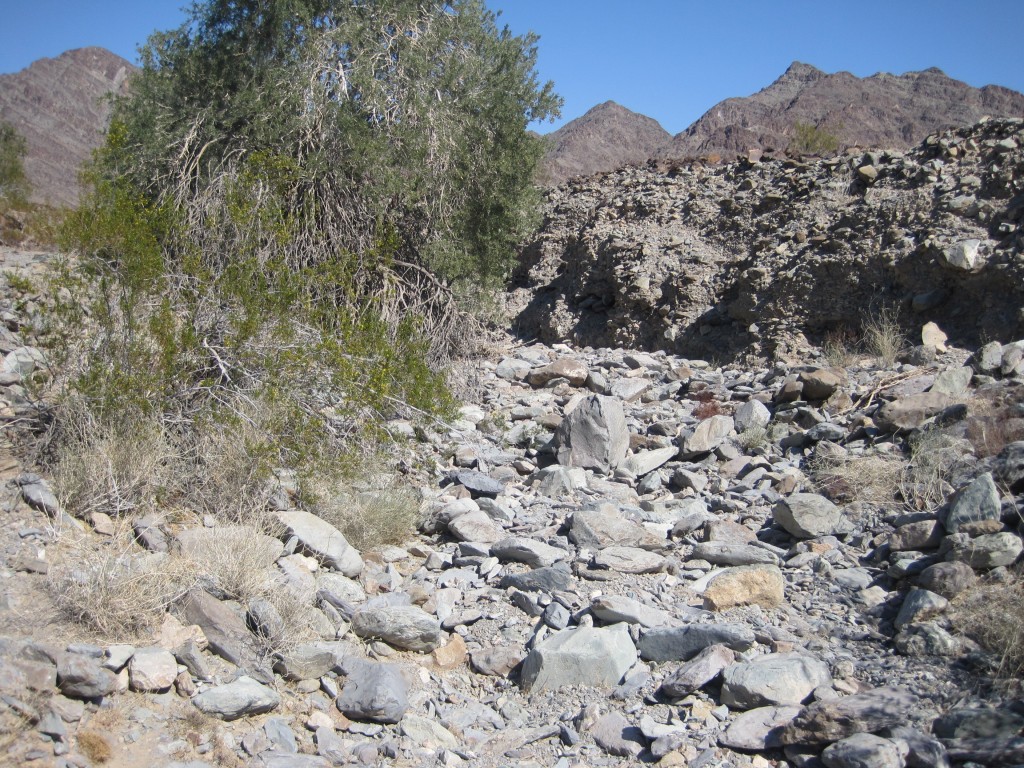
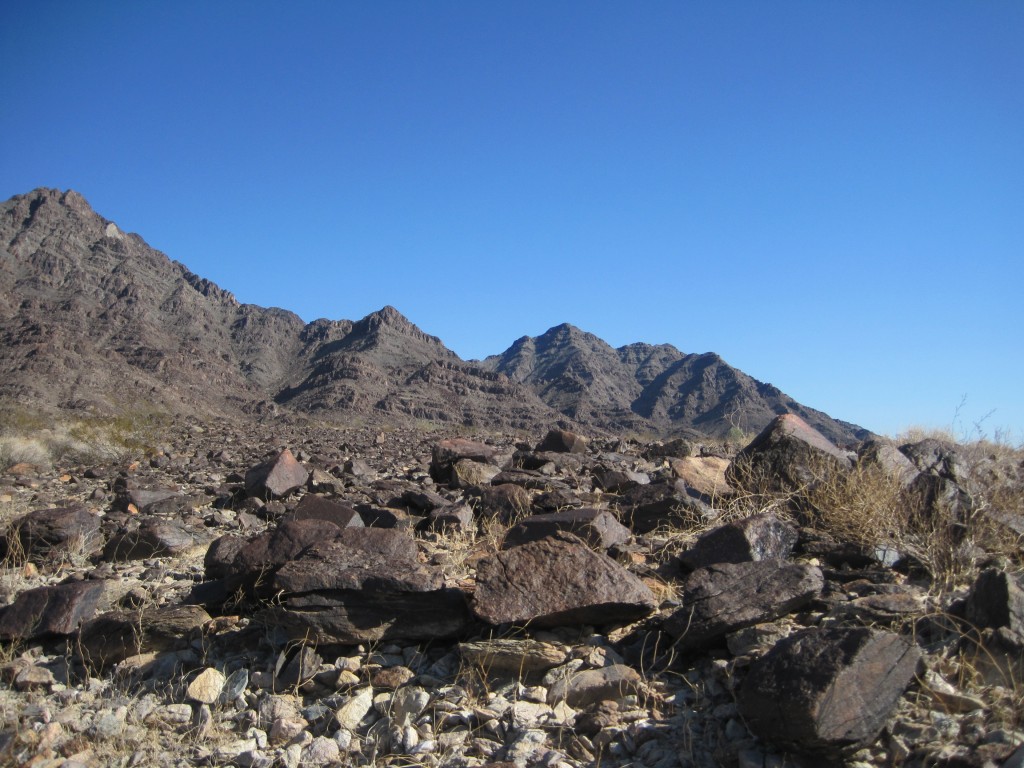
The winter had seen little rain in the desert and large blooms normally don’t occur until mid-April. But there was some flowers and plant life that encouraged time out for viewing and picture taking.
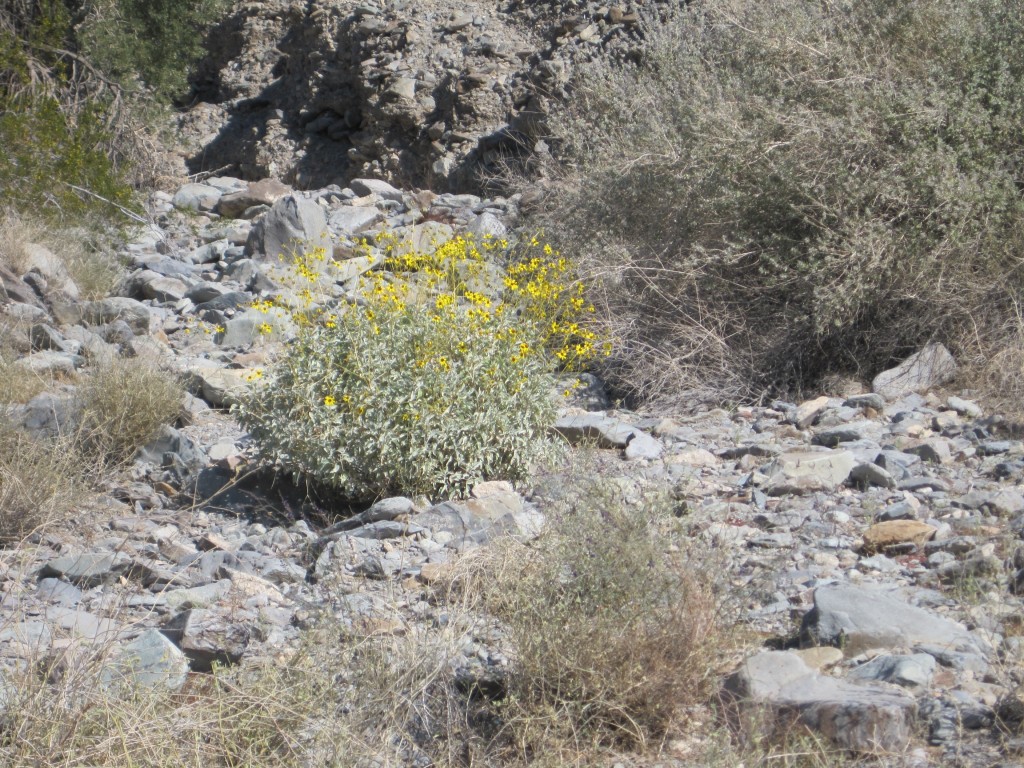
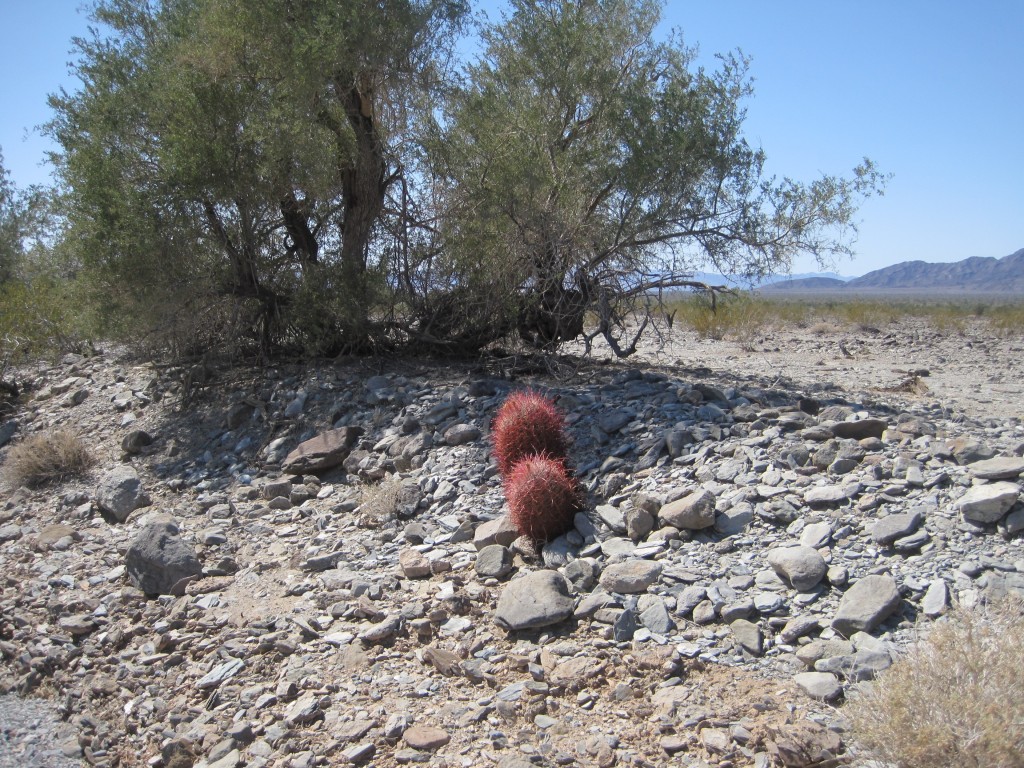
McHale Pack. The small volume of the pack bag was perfect at 33 liters. The optional water pocket can each hold a 64 oz Gatorade bottle. I placed the 6 one-litter Platypus bottles in the main sack, much easier to pack than two-liter ones. I also attached the optional hip pockets, shoulder strap pocket and top lid.
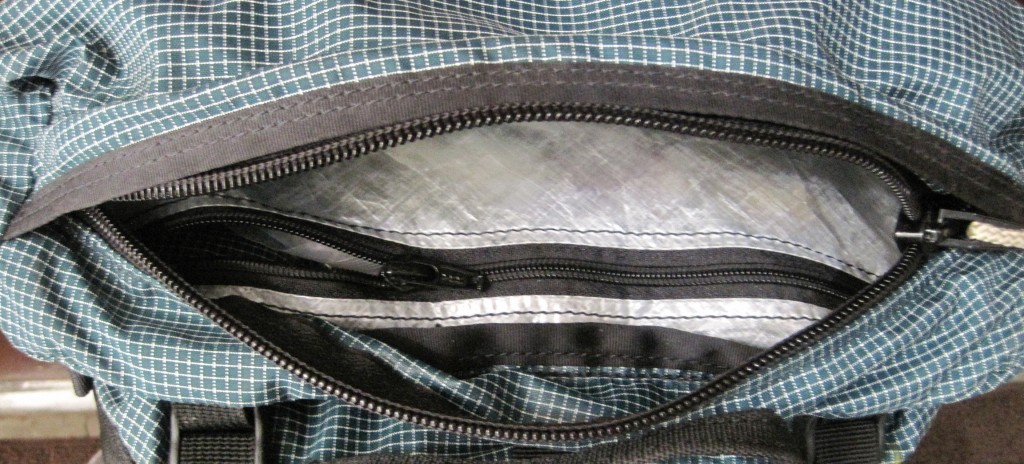
Picture of the McHale Top Lid. The top lid is a new design this year from Dan McHale. It is small but extremely functional. There is a second pocket inside made that is very handy for those small items that get lost easily. Normally I strip my packs down for short hikes, but I will probably take this lid on all my trips with this pack… it worked so well and is very convenient.

Every evening the wind picked up, and a wind shirt and beanie kept me warm enough for hanging around camp and doing chores.
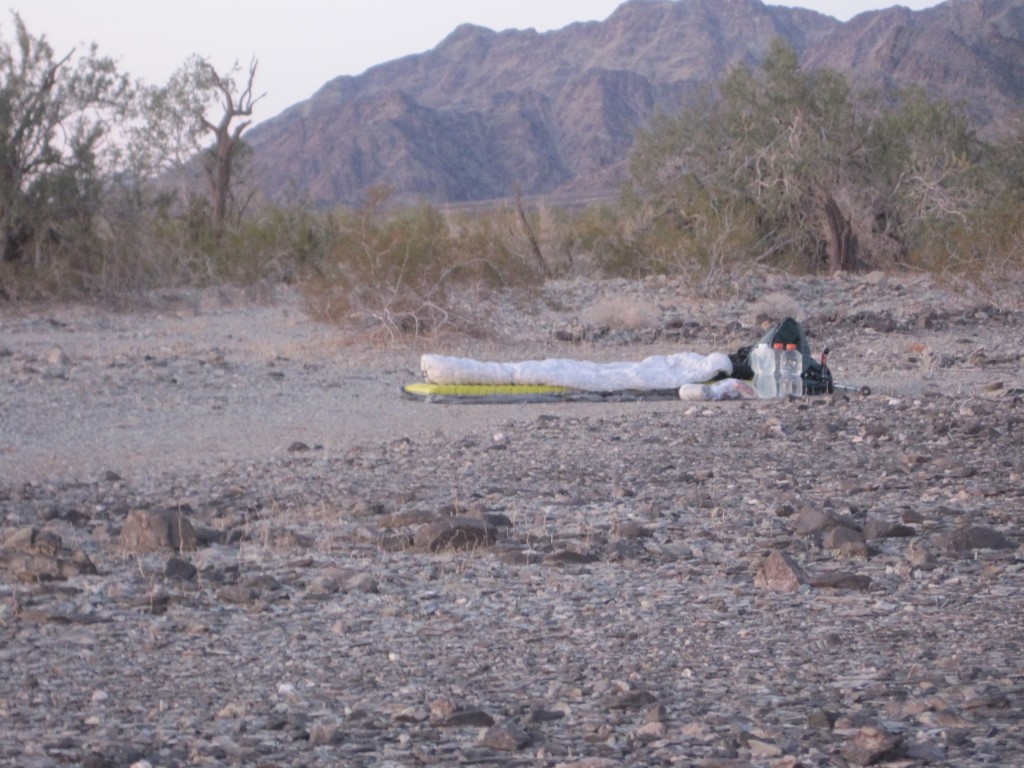
The best tent is no tent where the sky is your canopy. So the difficulty is finding a level spot, soft enough ground to keep from puncturing your air mattress, and a wind break from the wind. Trees and shrubs work well to break the wind, but one must be far enough away so nocturnal creatures don’t feel they have an open invitation to your camp. This site offered wonderful 360 degree views, shelter from wind, and early morning sun. What else could one ask for?
People tell me they don’t like to hike alone; they get lonely with no one to talk to. They also tell me they get bored at night, needing reading material or music to keep them company. I don’t understand it. So here is my recipe for a wonderful evening and peaceful sleep…
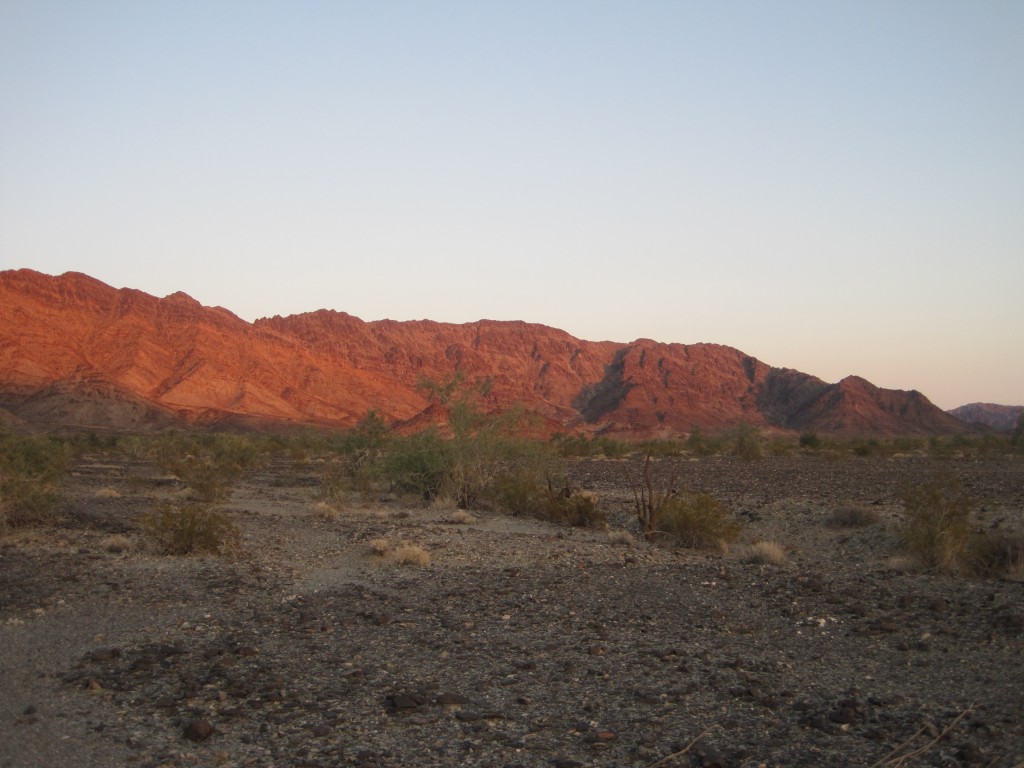
Red Rock. Watch the setting sun play with your surroundings. Here the normally black mountains are bright red.
Sunset. Watch the sun set. Observe colors and shadows.
Moon. Learn of the night sky. My camp was oriented with the rising moon behind me. When nightfall arrived, I watched Venus and Jupiter play with the horizon. Once they set below the horizon, I observed a nearly full moon and at times looked at it with my binoculars. Soon I dozed off. Awakening in the early morning around 3 AM, the moon was setting and I watched the winter sky, especially the Orion constellation. Next thing I knew it was daylight and I was awakening from a glorious night’s sleep. Pretty simple stuff.
At home, I am not a big breakfast eater, but on the trail it is my favorite meal. Sleeping under the stars means there is little to do when packing up camp, so a leisurely breakfast is always in order, weather permitting. Umm, umm good!
PETROGLYPHS
Vandalism. Here is an example of vandalism, and why I am trying to hide this Secret Place. Although with a little research you can find it. But it is not easy to get to. The petroglyphs that have been damaged in this picture are over 5,000 years old. Scientists can determine the age based on the amount of “desert varnish” that covers them.
The petroglyphs below have remained undamaged for centuries.
I did find water in the spring and was able to complete the loop. Here is my reflection.
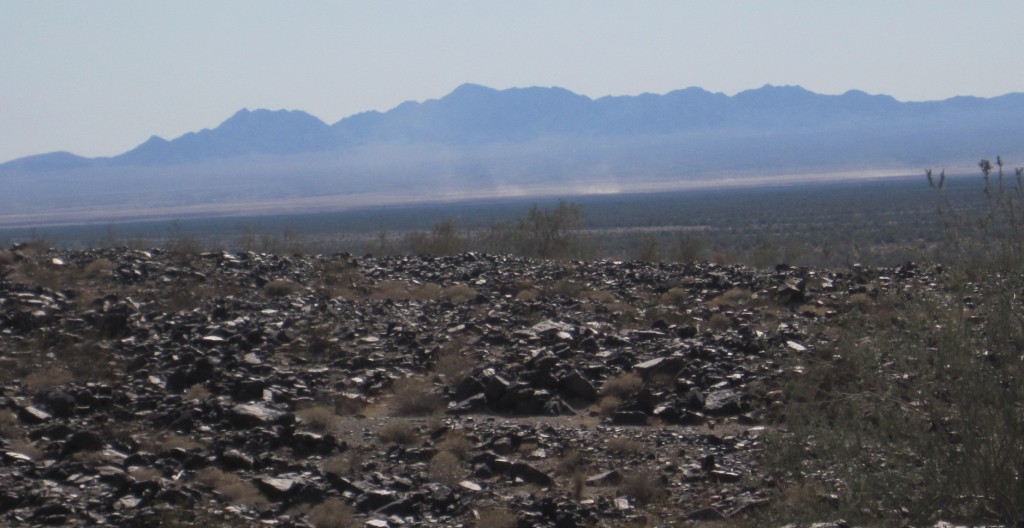
Sand Dunes. Many people think of vast mileage of sand when they think of deserts. And sometimes it in abundance. But I walked on very little sand. However in the distance is a dry lake and the wind has created a haze from the blowing sand. Probably hard to see, there are 3 large dust devils several hundred feet tall. But it is relatively calm where I am standing.
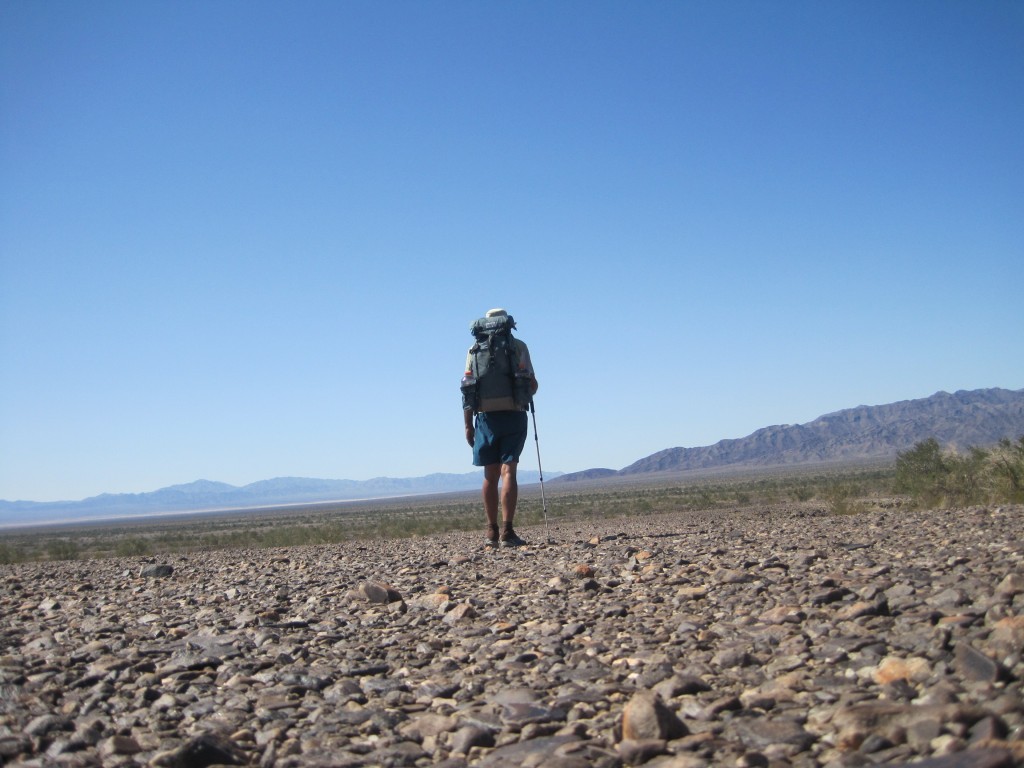
Desert Pavement. Desert pavement is the surface that is covered with packed rather rounded rocks. It is so hard that you can drive a vehicle across it at high speeds. Also, allows one to walk quickly!
Desert Pavement
More Desert Pavement.
GEAR FAILURE
I had two minor failures.

The first was a pinhole in my Foster’s can. The can does double duty as my cook pot and drinking cup. My stove, cup and utensils only weigh a total of around 4 ounces. A small pinhole developed right at the middle fold. I have “babied” this can and it has been on many, many trips as you can see from the discoloring. To be honest, I am tired of arranging my pack to put it in a spot where it will not get crushed. So I will probably switch to a titanium pot system. I would much rather put the pot where it makes sense packing-wise and stop worrying about crushing it.
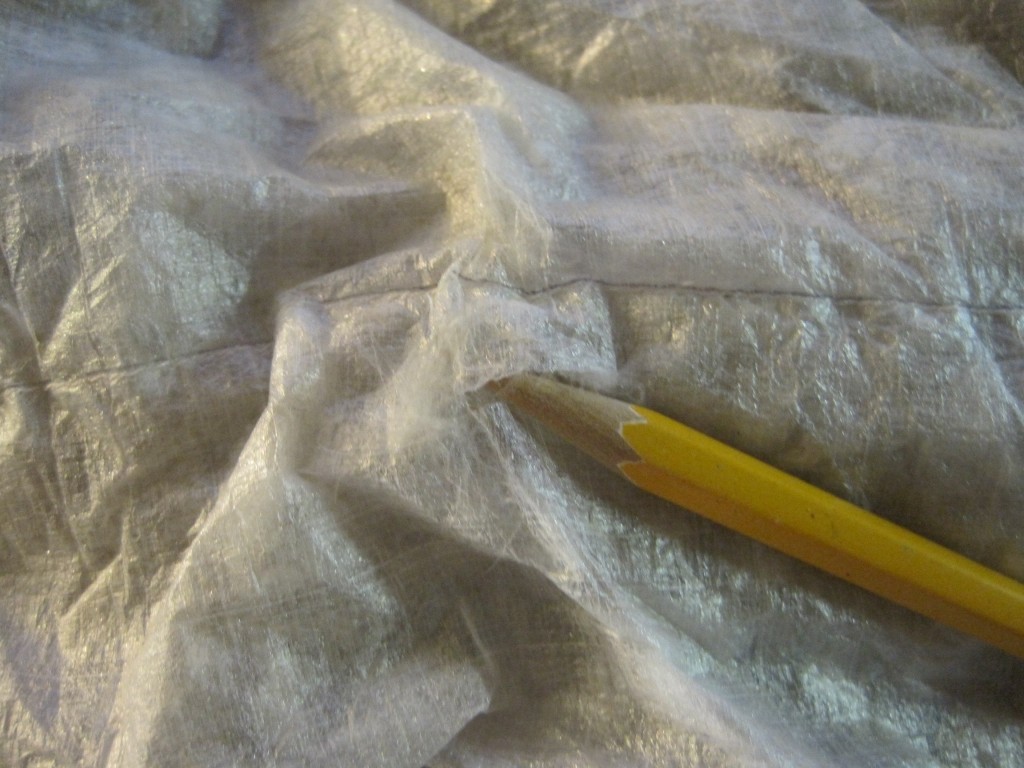
When I was putting away my quilt, I saw some feathers floating in the air. On closer inspection I noticed this tear at the top of the foot box. Since I always put the quilt in the stuff sack, and never have the top of the foot box on the ground, I first thought it might just be material fatigue, but I probably punctured it with a finger nail. The material is made from very thin CubenTech cloth. CubenTech is used to make sails for the America’ Cup racing yachts, light and strong for that application, but somewhat fragile in the thickness for my quilt. The quilt only weighs 12 ounces and is warm to just below freezing.
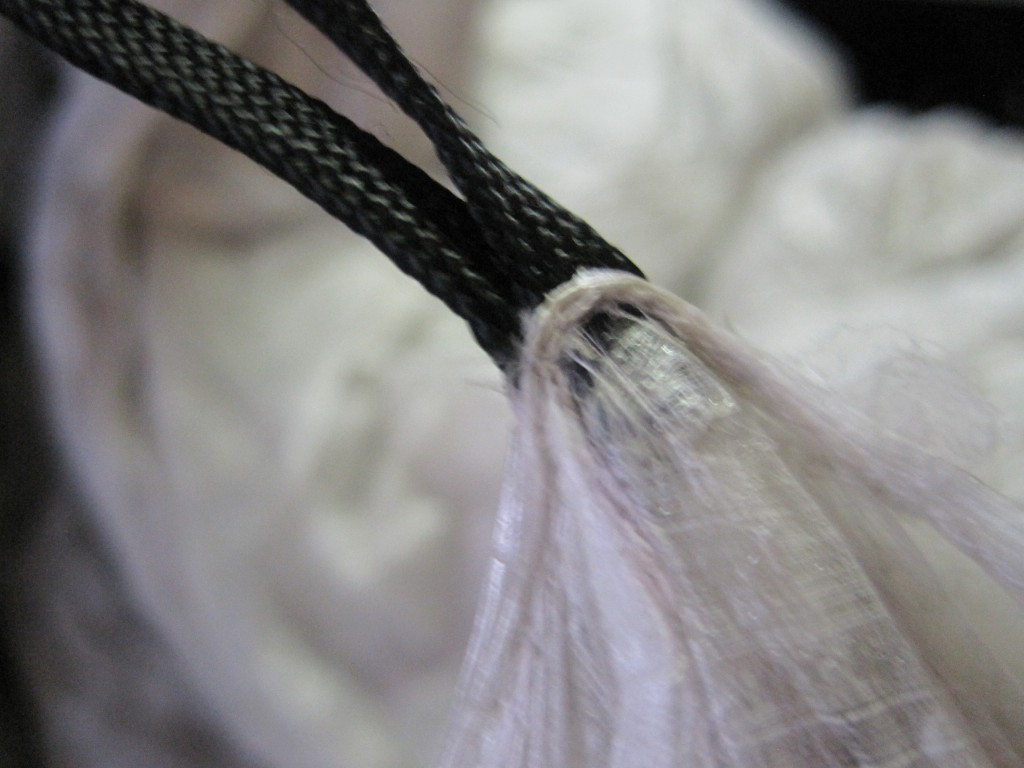
I also noticed that one of cord loops is pulling away from the cuben. These are the perils of truly UL equipment.
GEAR
The McHale Bump pack thoroughly exceeded my expectations. Handles 35 lbs with ease, and the internal aluminum stays inside the pack are used as the frame, keeping the pack close to my center of gravity. This was an expense that was well worth the investment. The only difficulty through the entire purchase process was figuring out what material to make it from. Dan McHale wanted to make it from CubenTech fabric. I am leery of Cuben for the long term (as you can see in the pictures of my quilt above, as I expect this pack to last for at least a couple decades, and no one has used cuben for that long in a pack to report on its durability. The Cuben that Dan uses is a hybrid with a polyester laminate and he has tested it thoroughly. So I opted for Dyneema X Grid. The fabric Dan uses has the Dyneema threads spaced at 3/16” of an inch, versus the ¼” most of the UL manufacturers use. So his has about 25% more Dyneema thread in it. The pack has a full Dyneema bottom and the back of the straps is also made from full Dyneema. Dyneema is the strongest material known, and has replaced Aramid as the preferred material used to make military bullet-proof vests. The front of the pack has a mesh panel to help with sweat.
Specs on the pack
- Main Bag Volume (excludes any accessories) ~ 2,000 cu in or 33 L.
- Main Bag Volume (including the 11” roll top) ~ 3,000 cu in or 49 L.
- The stays and internal pad are removable. The padded double buckle hip belt is removable.
Options included
- Top Lid
- Water Bottle Pockets (easily hold 2 Liter water bottle); 2 each
- Hip Belt Pockets; 2 each
- Shoulder Strap Pocket; 1 each
Weights
- Stripped down without Stays, Pad, or hip belt = 25.15 oz (1lb 9.15 oz)
- Note: stripped down you can add a simple web belt.
- All Options Included = 51.92 oz (3lb 4.92 oz)
Gear Summary

